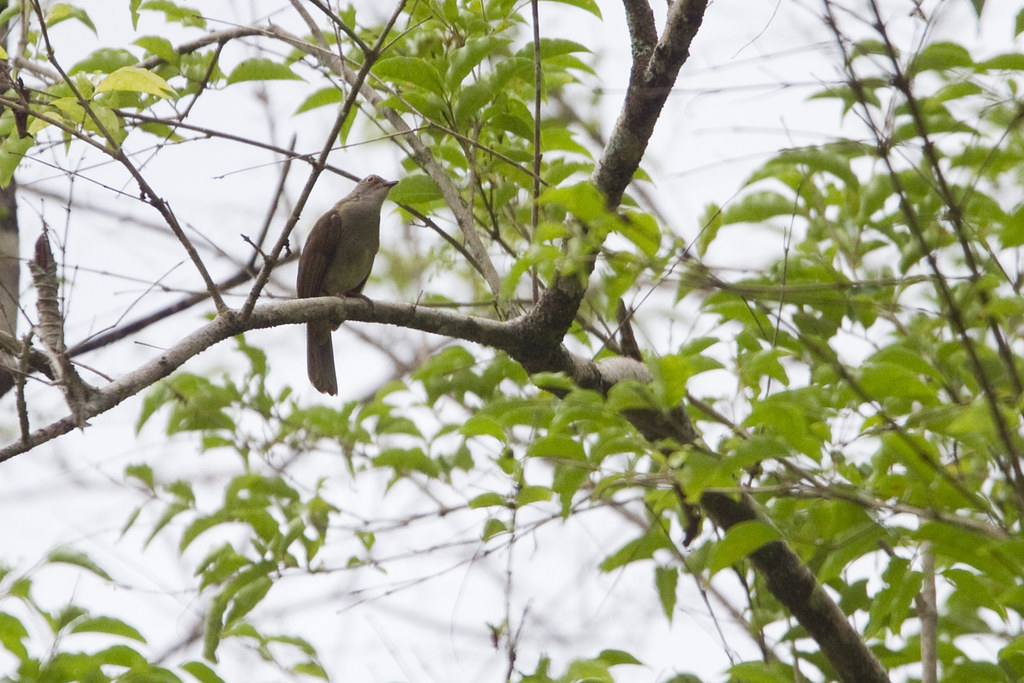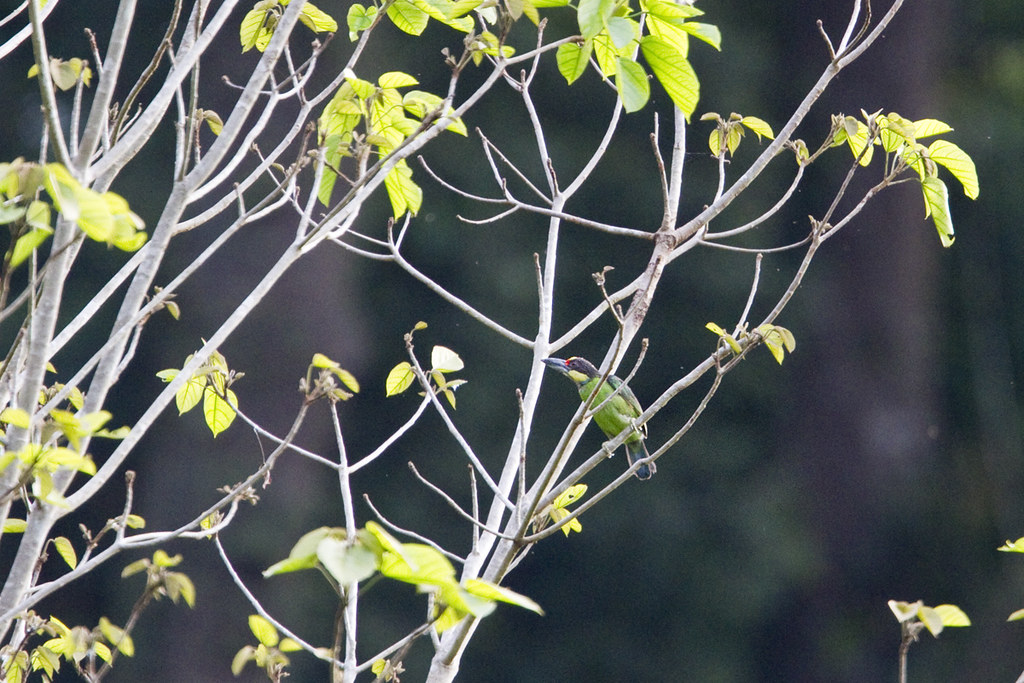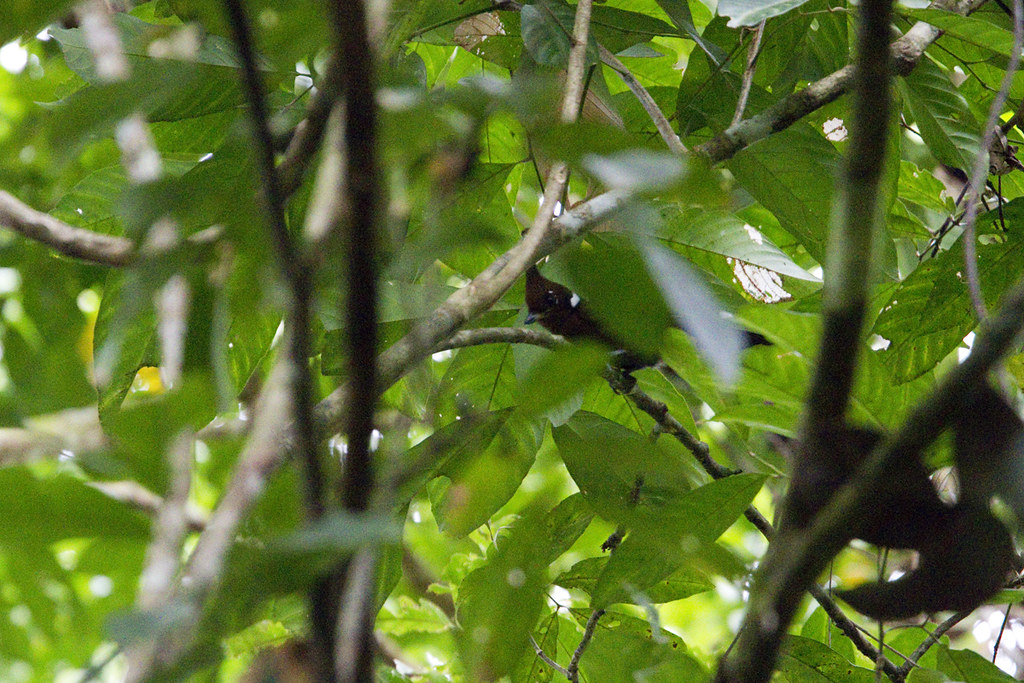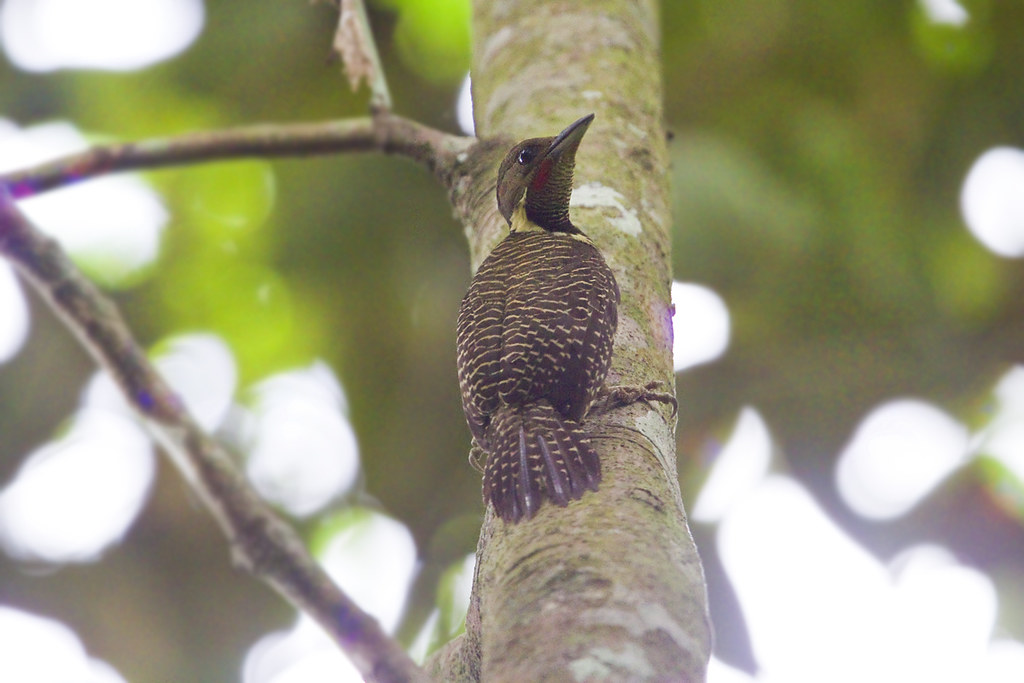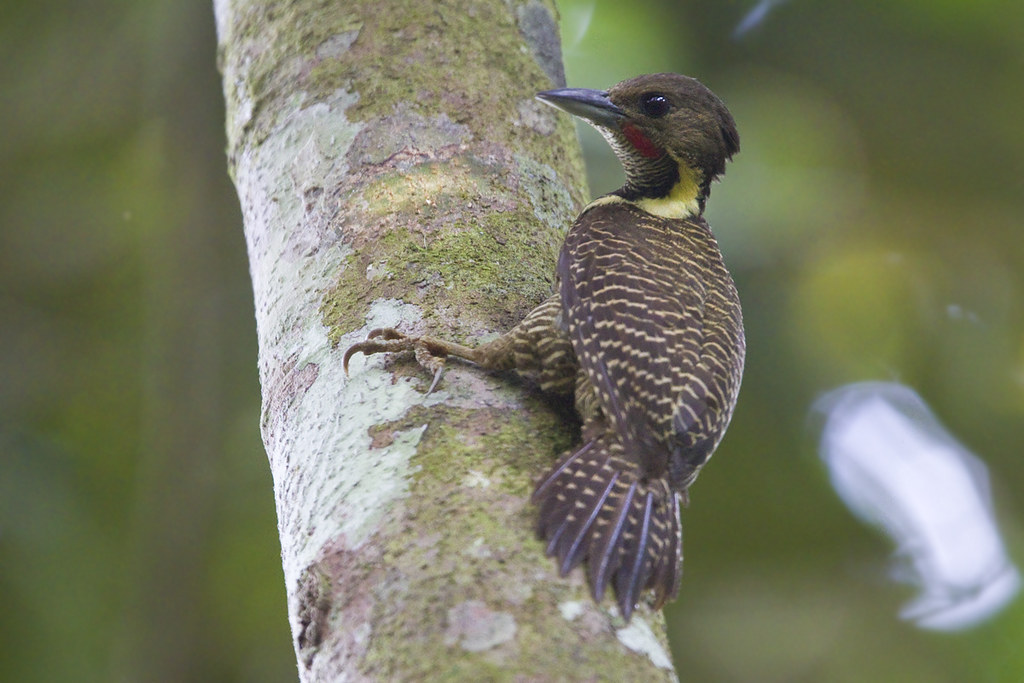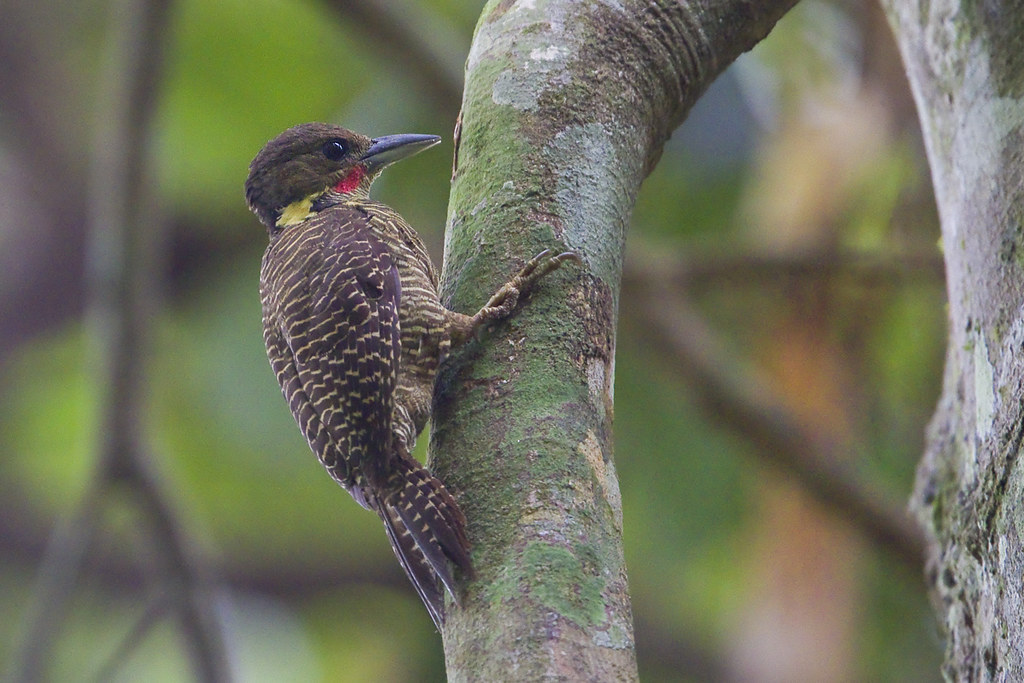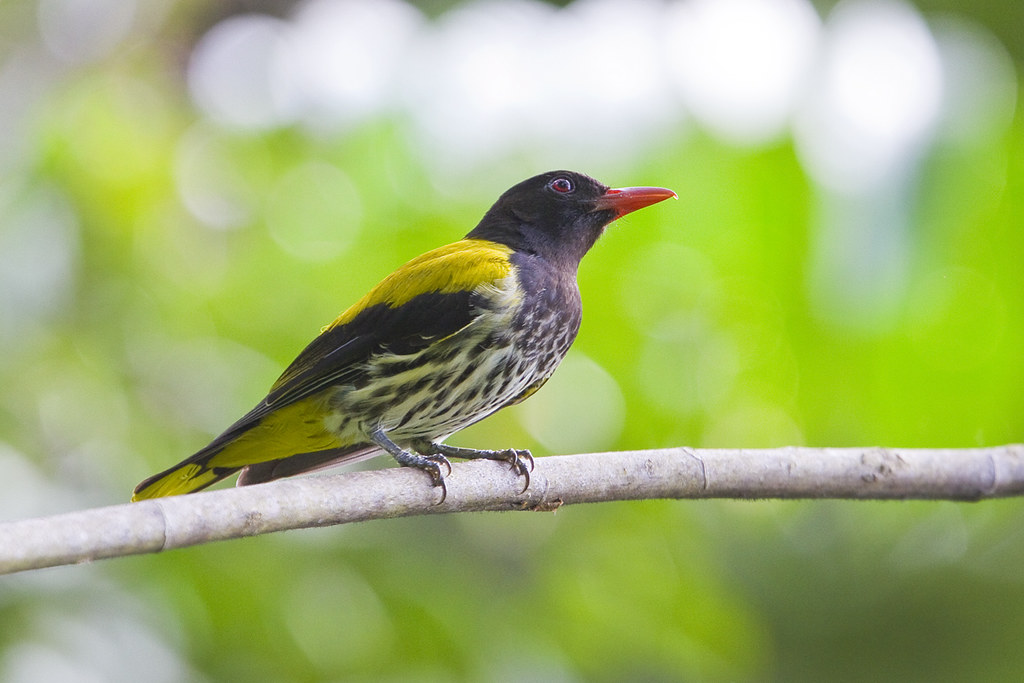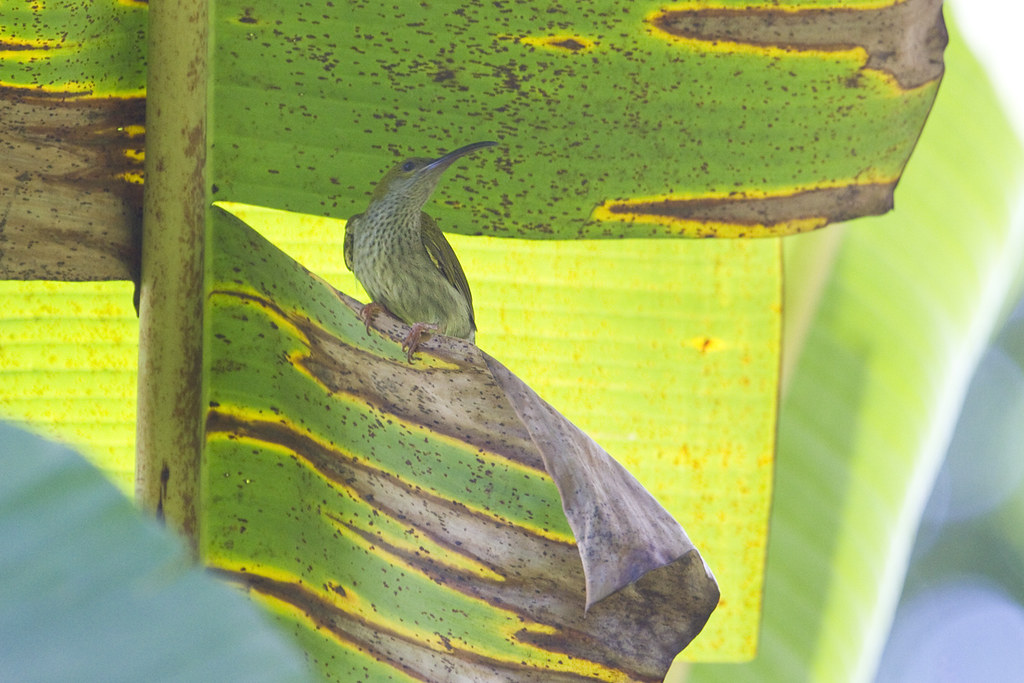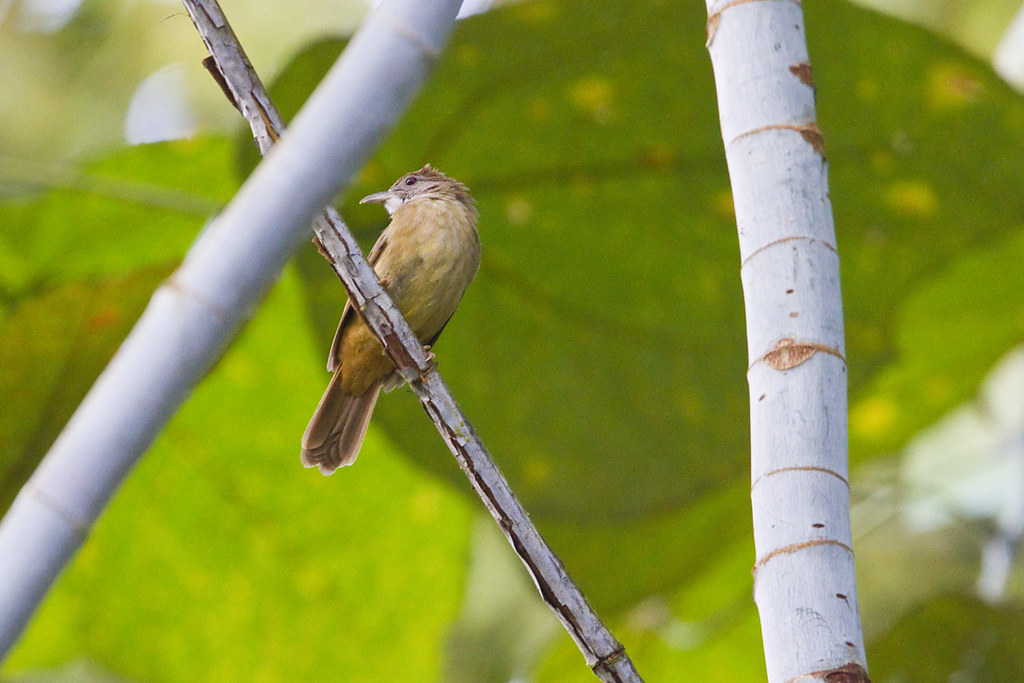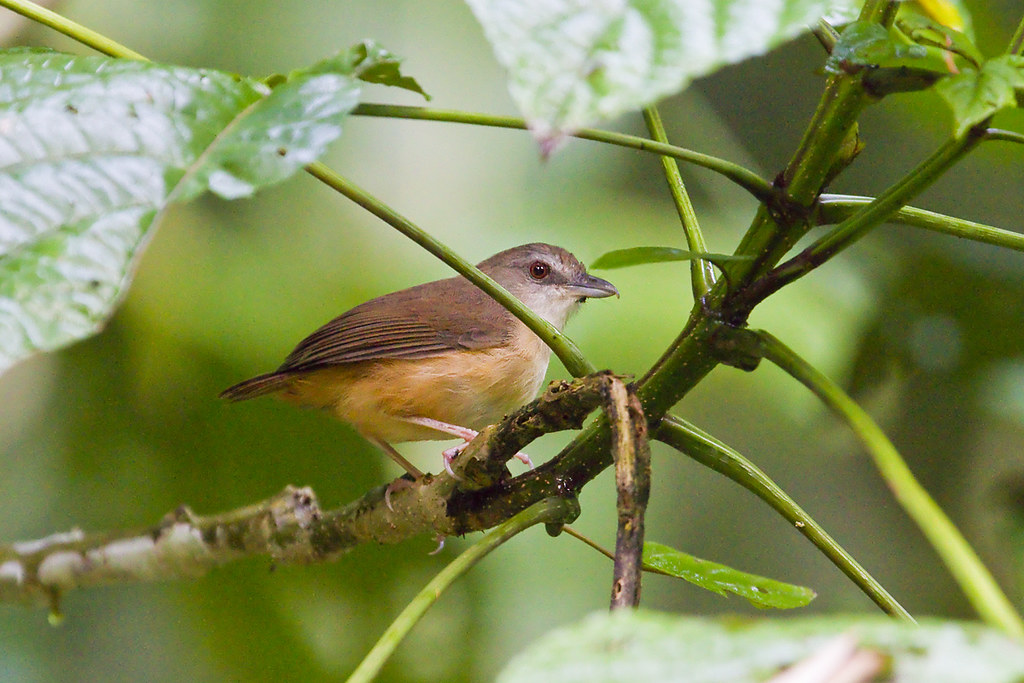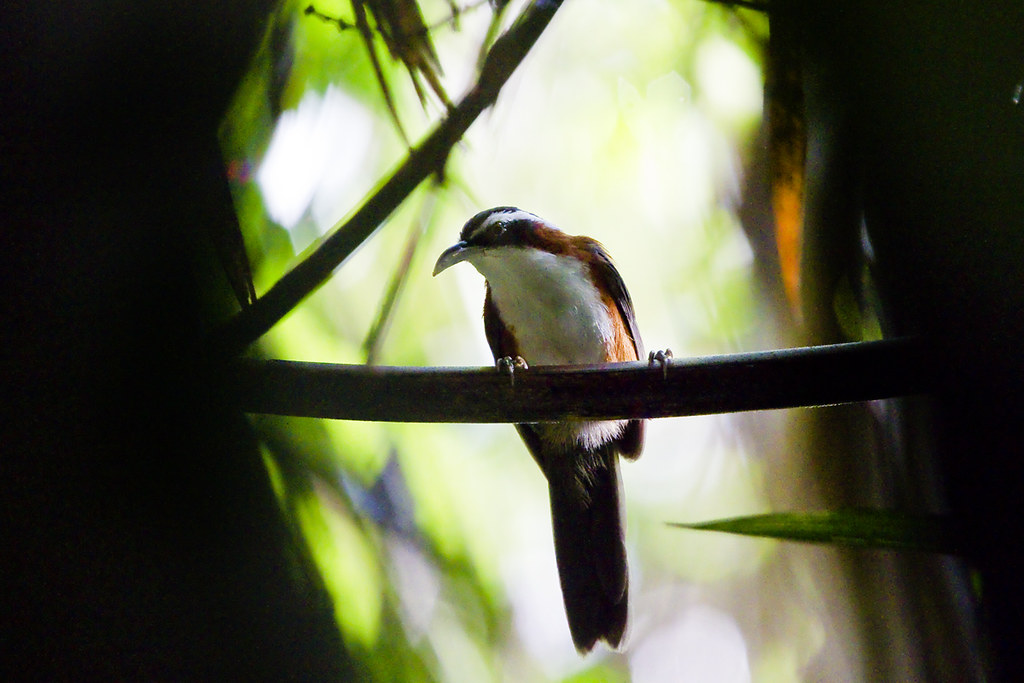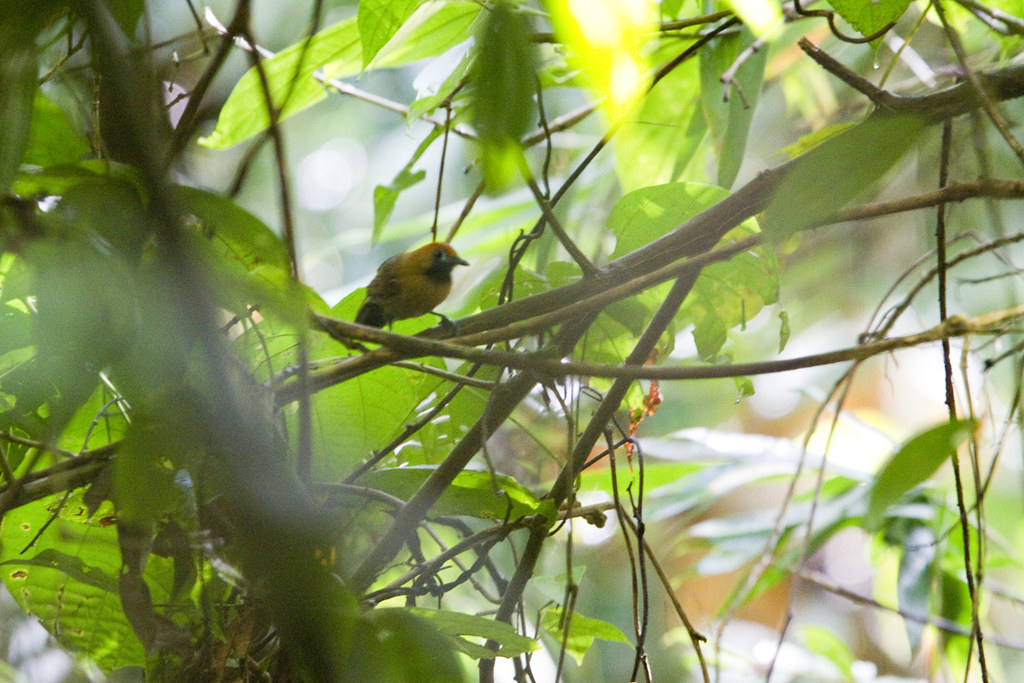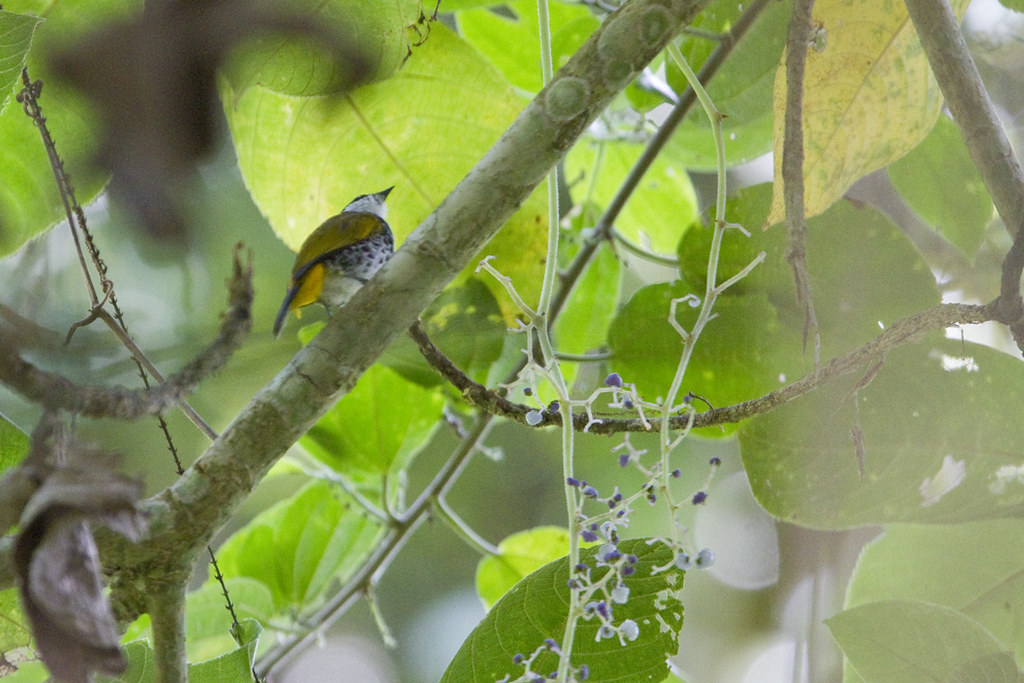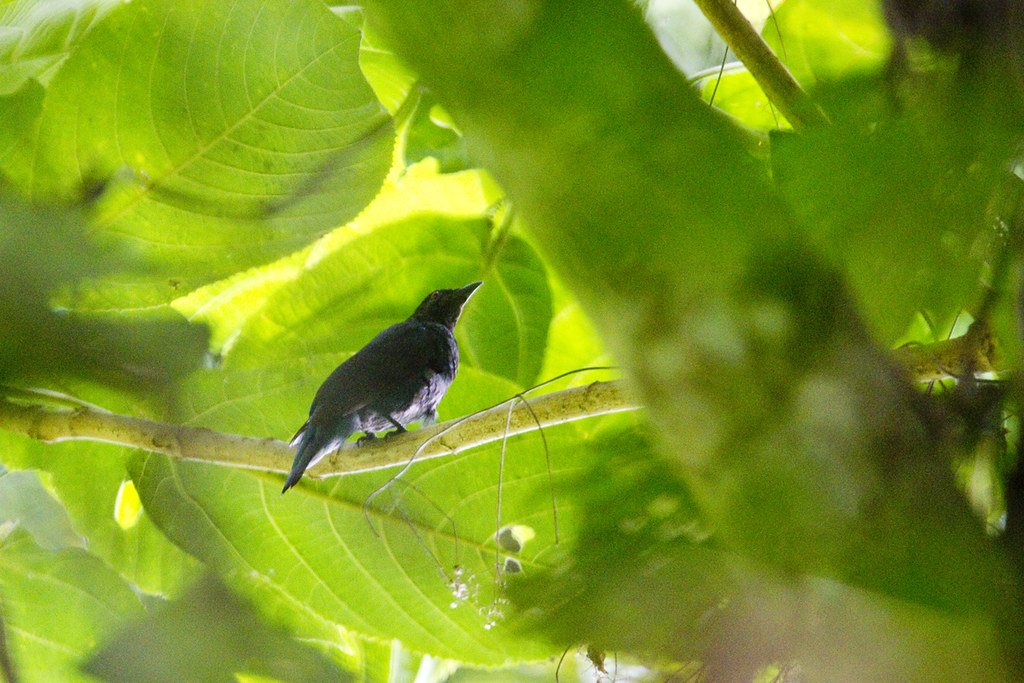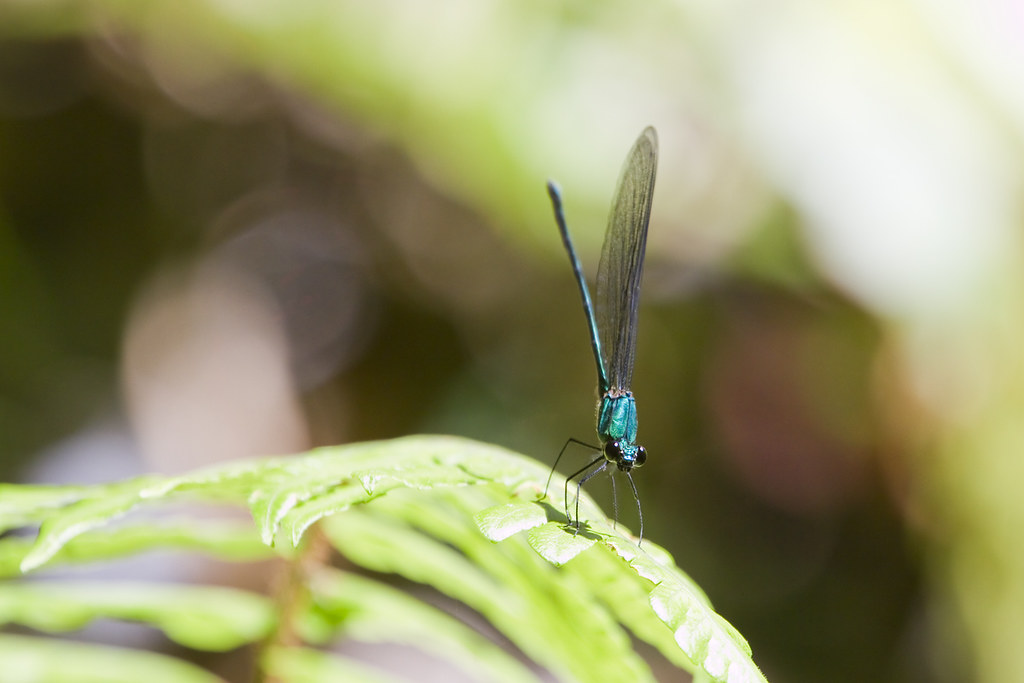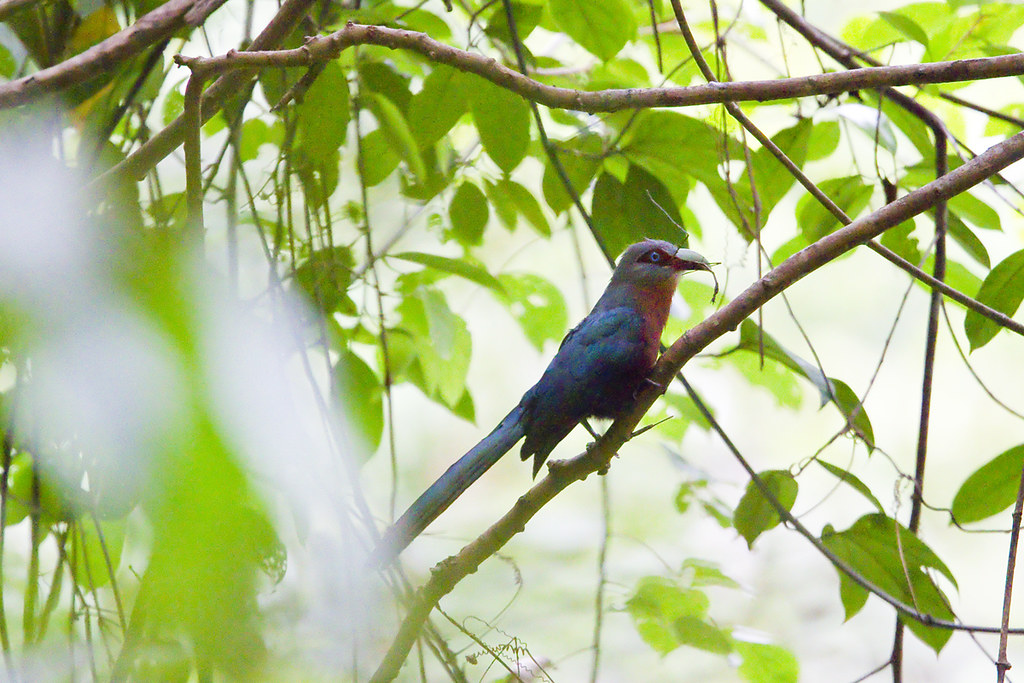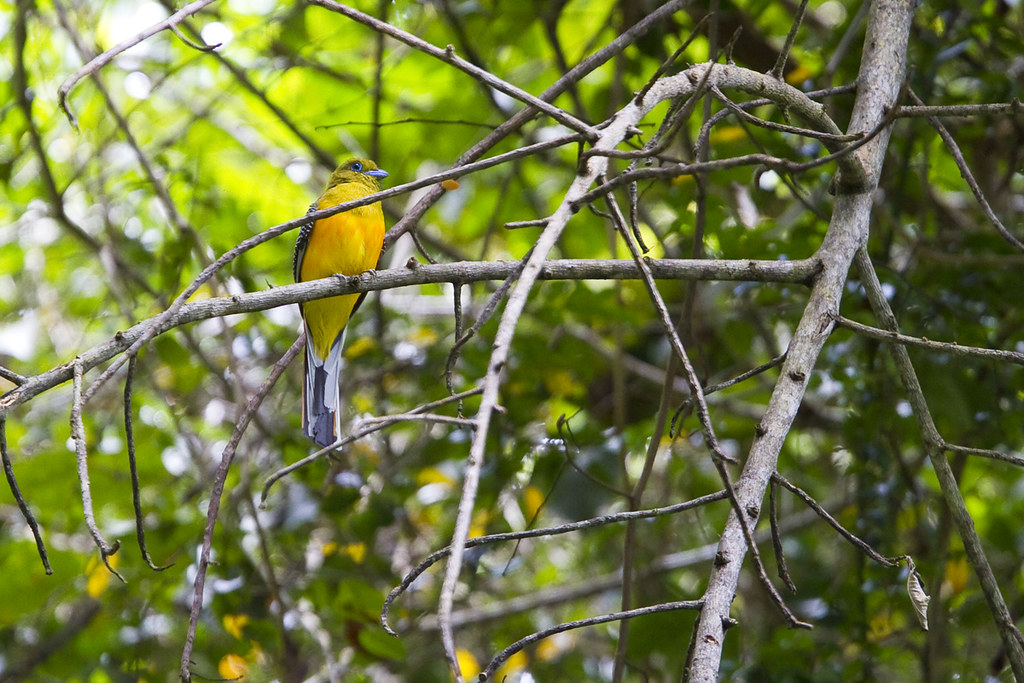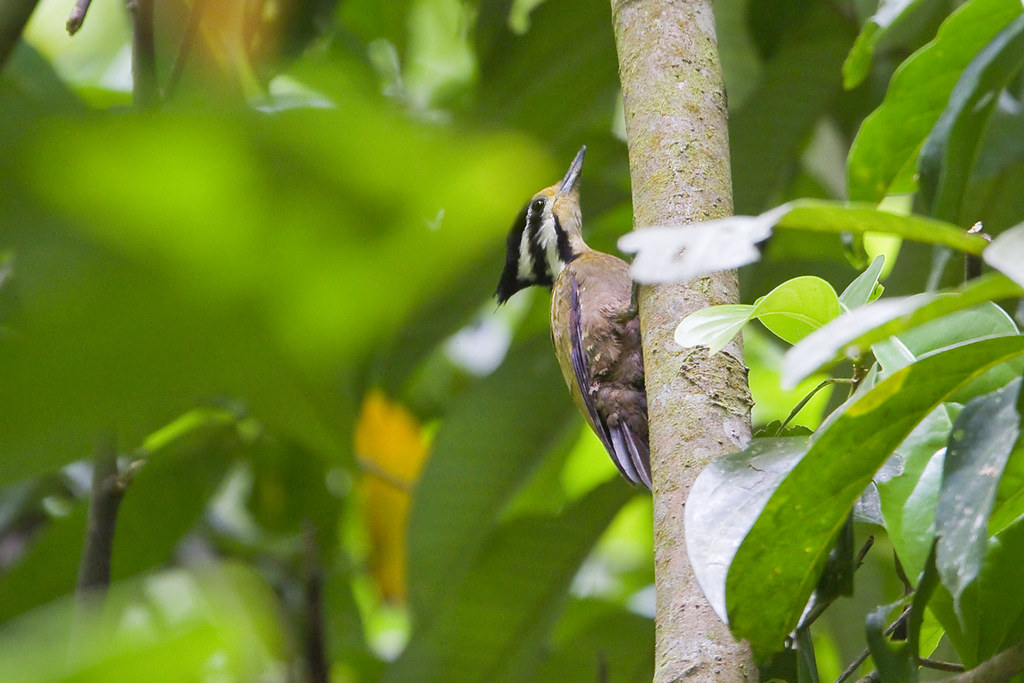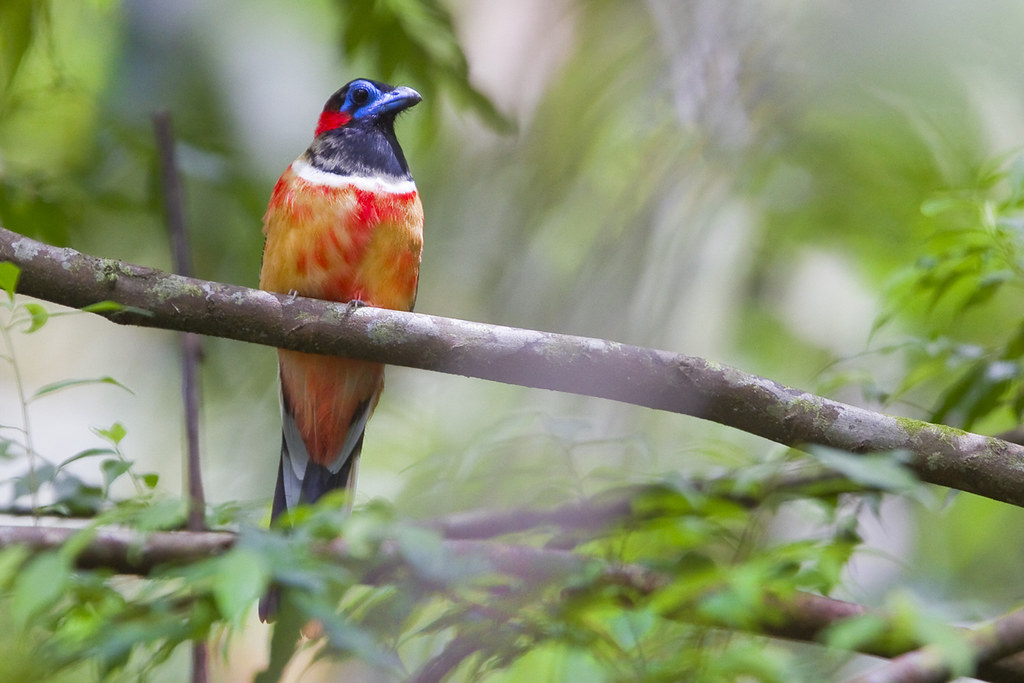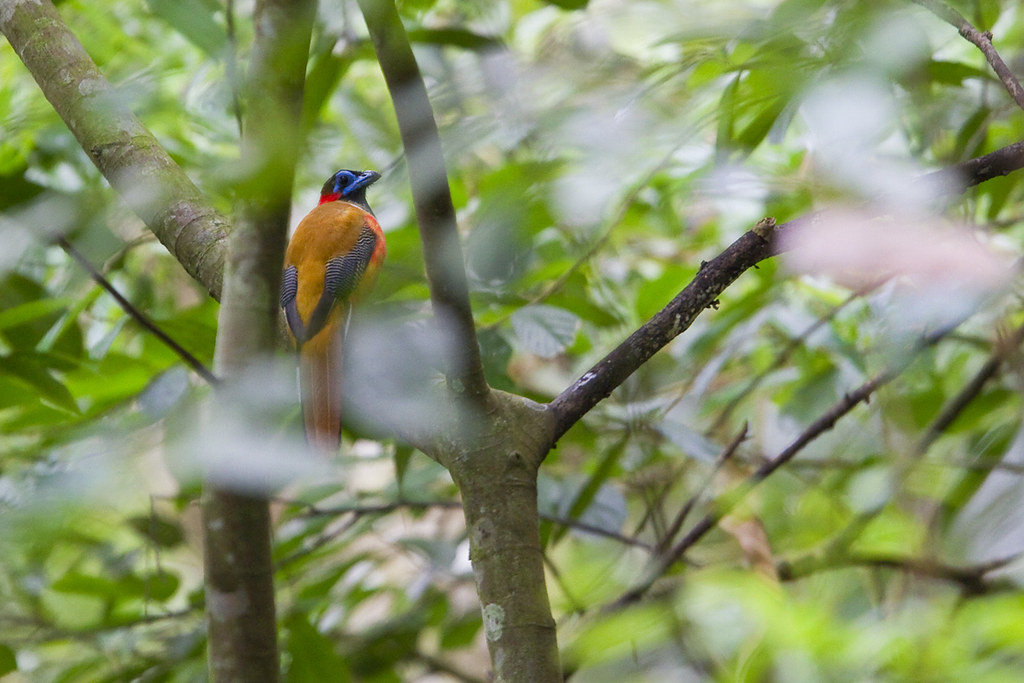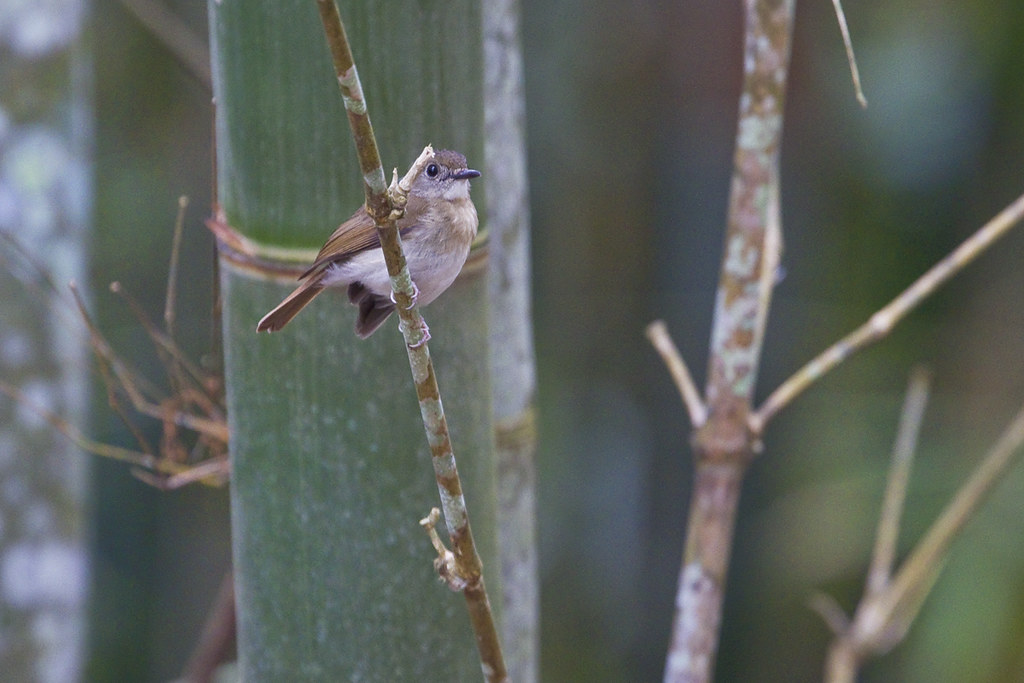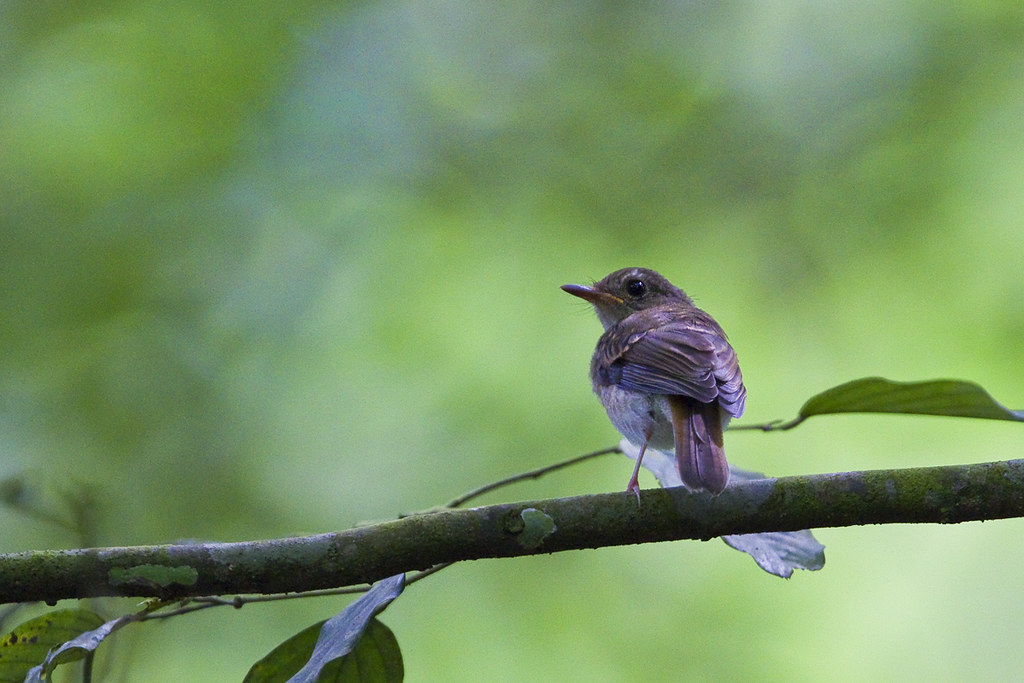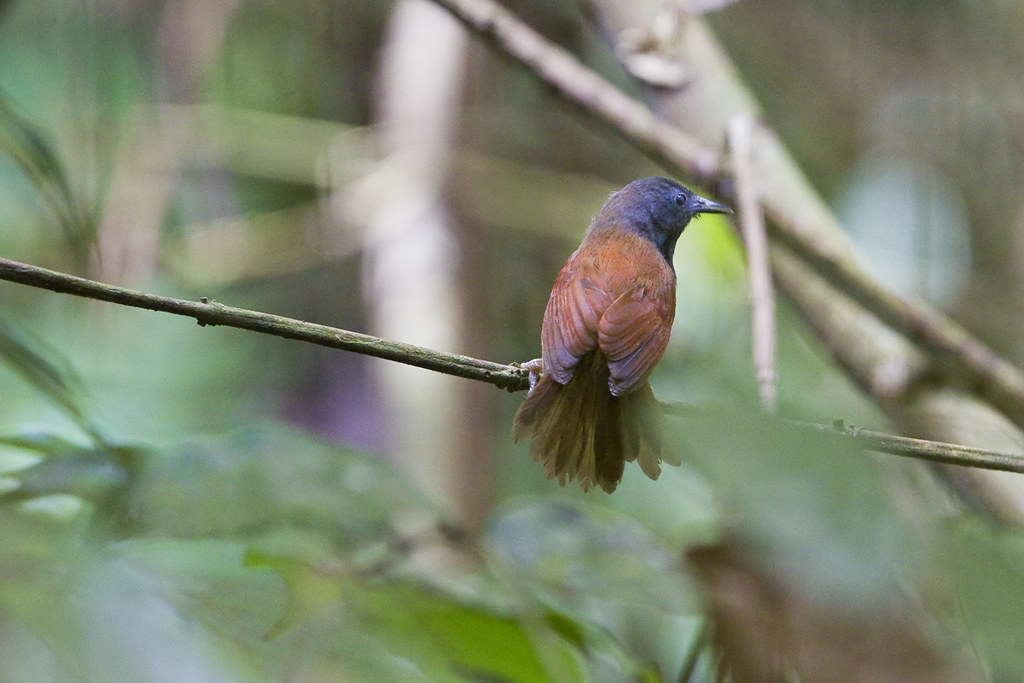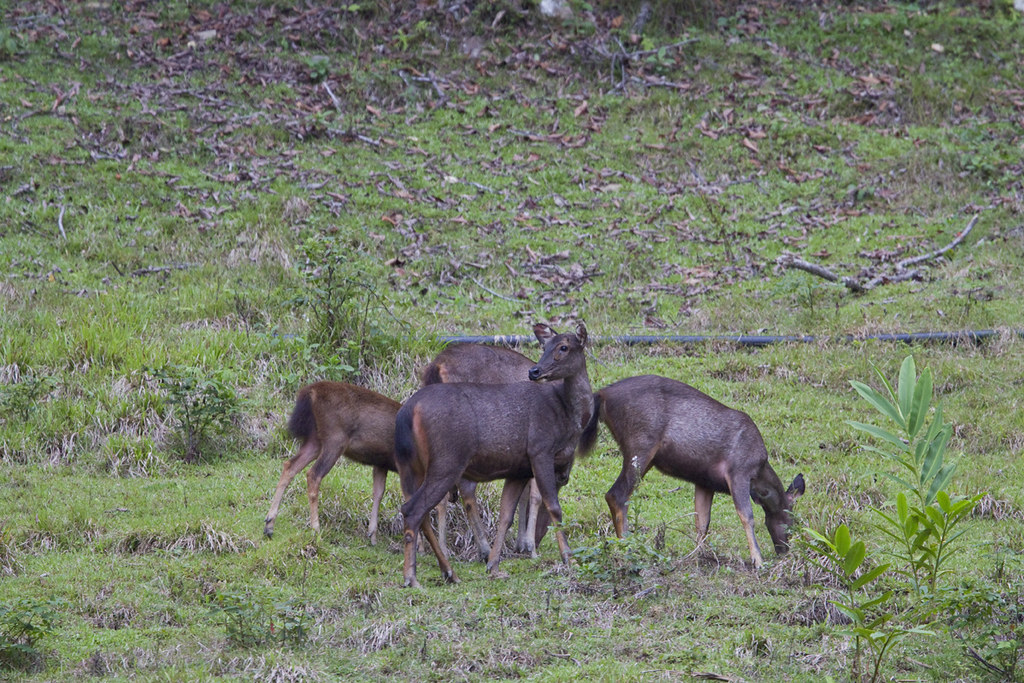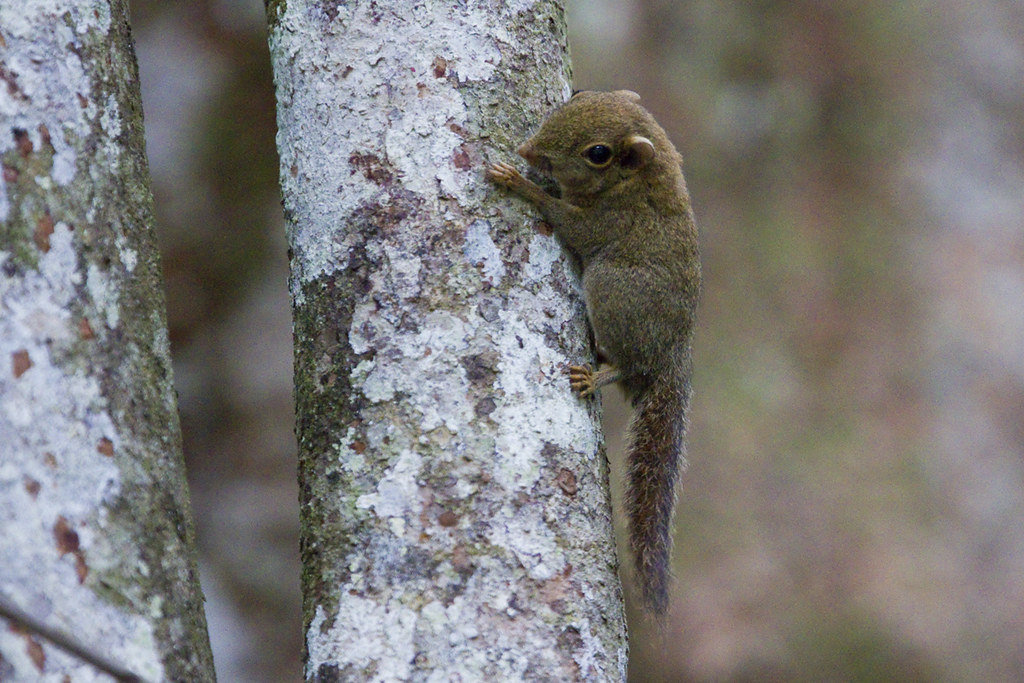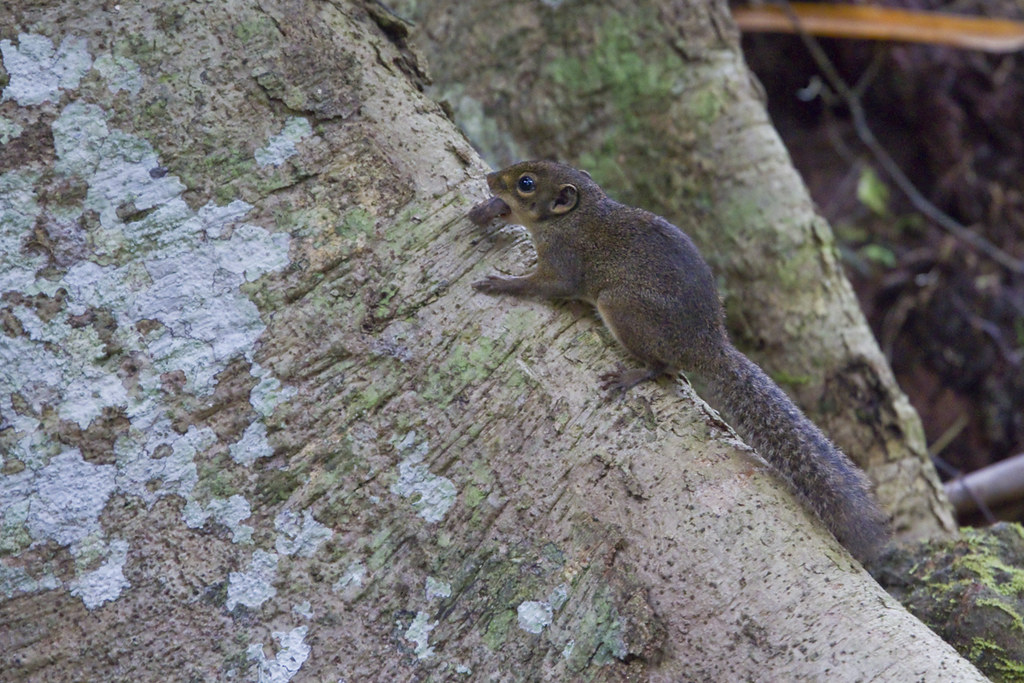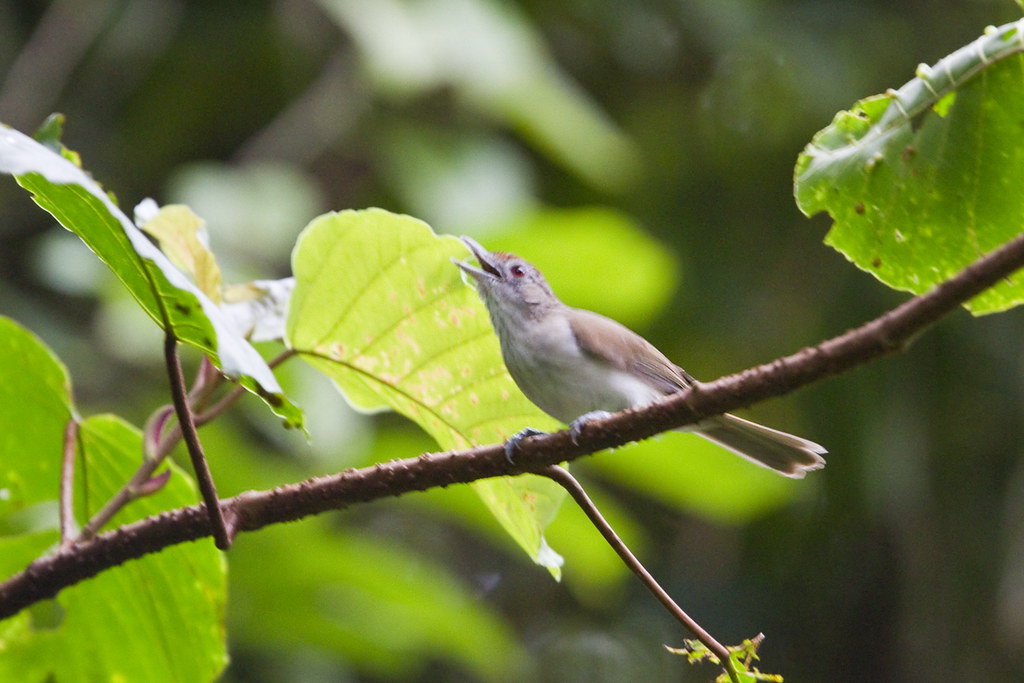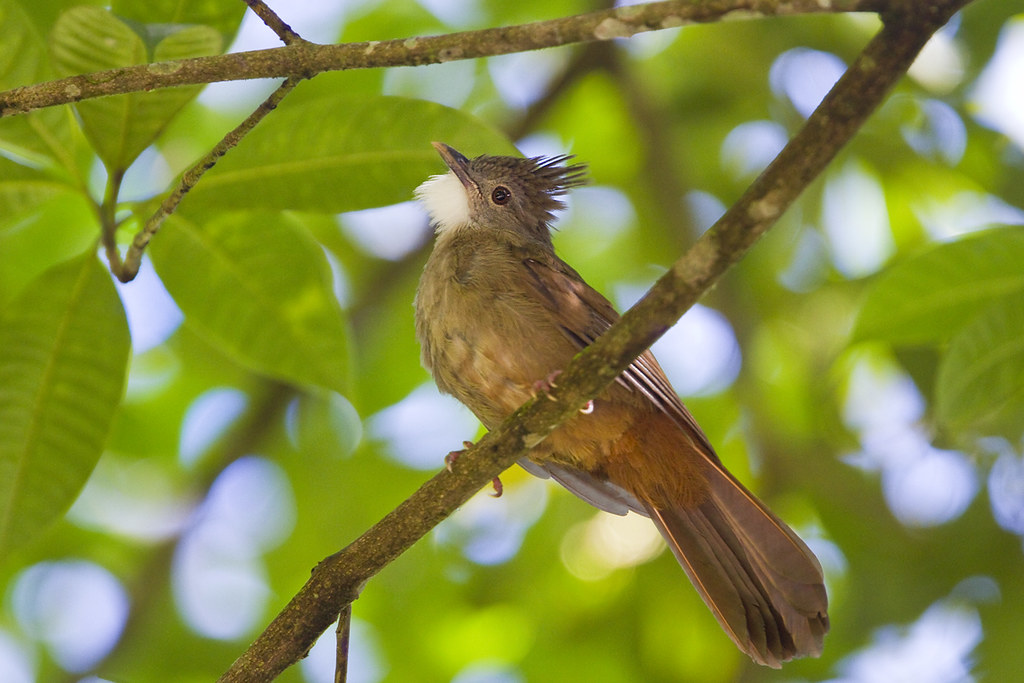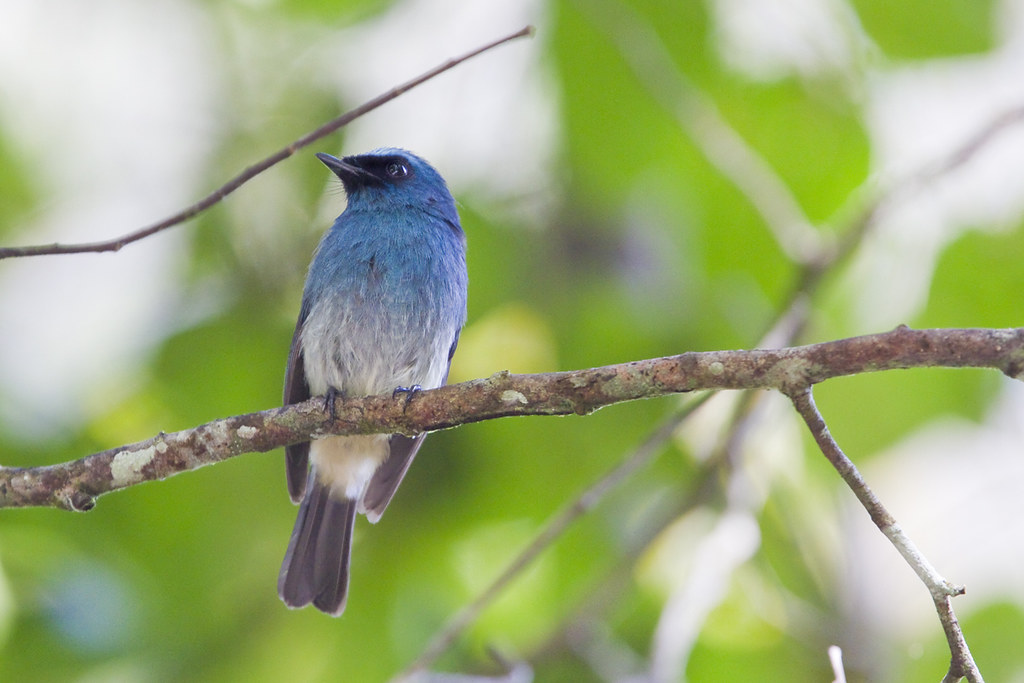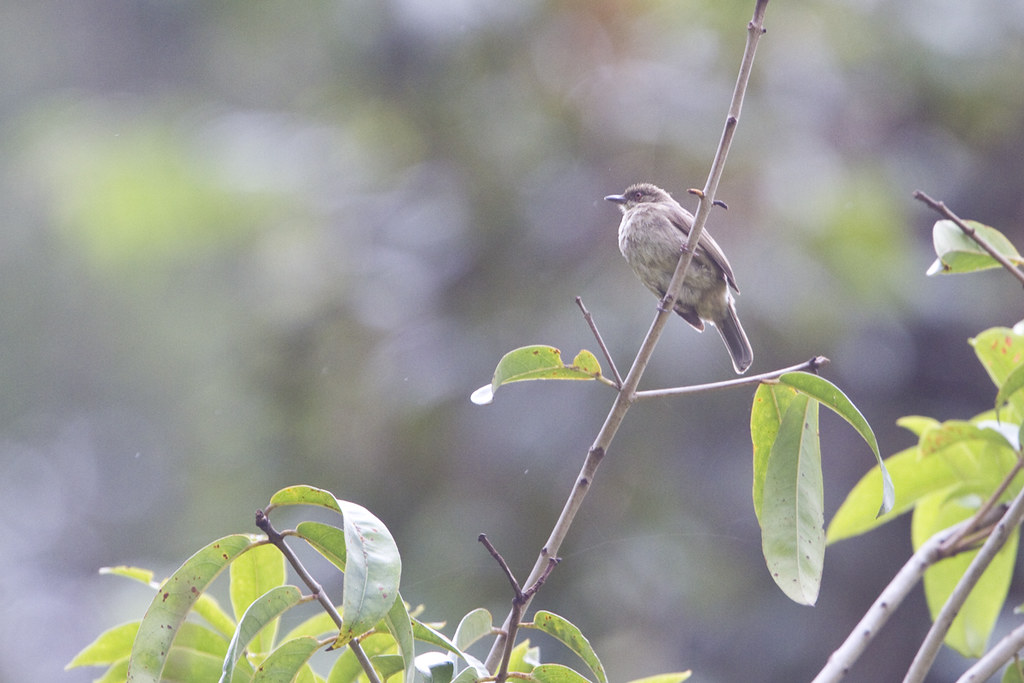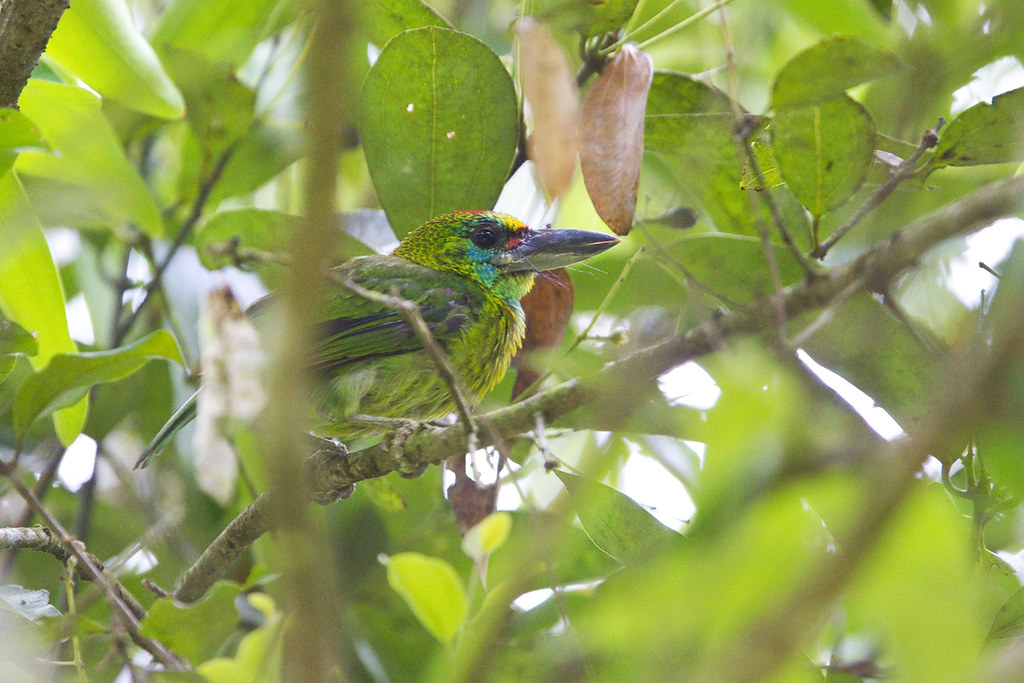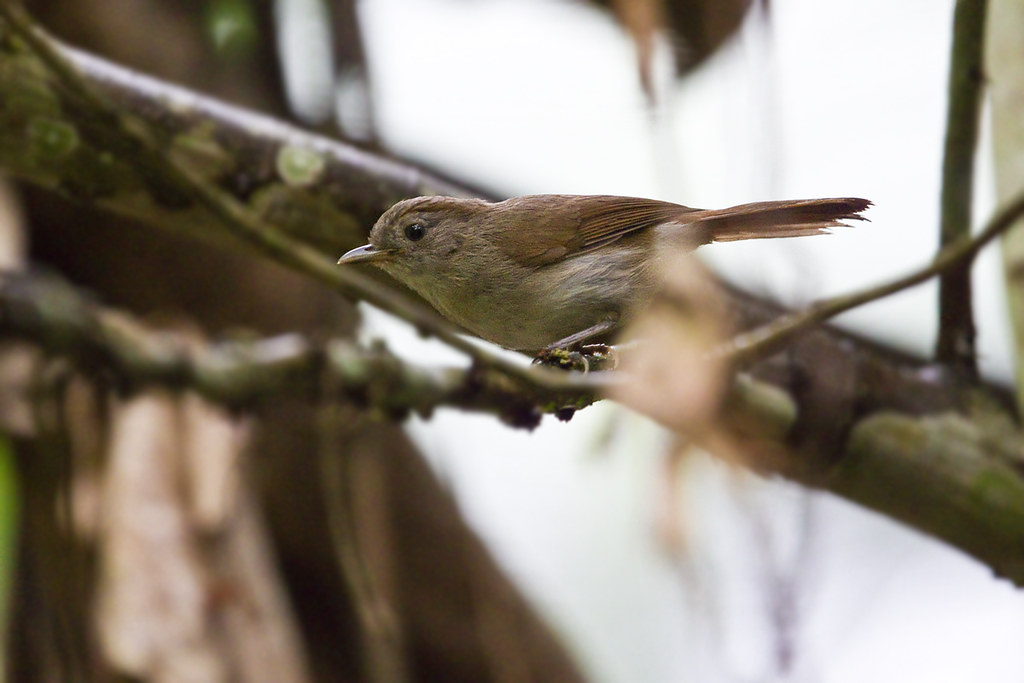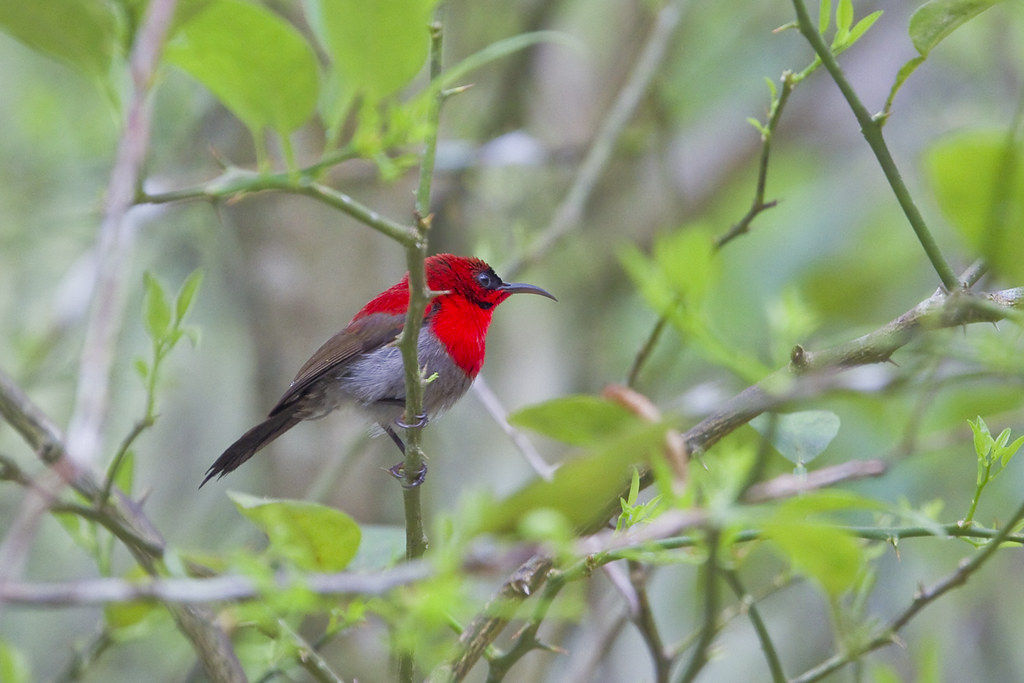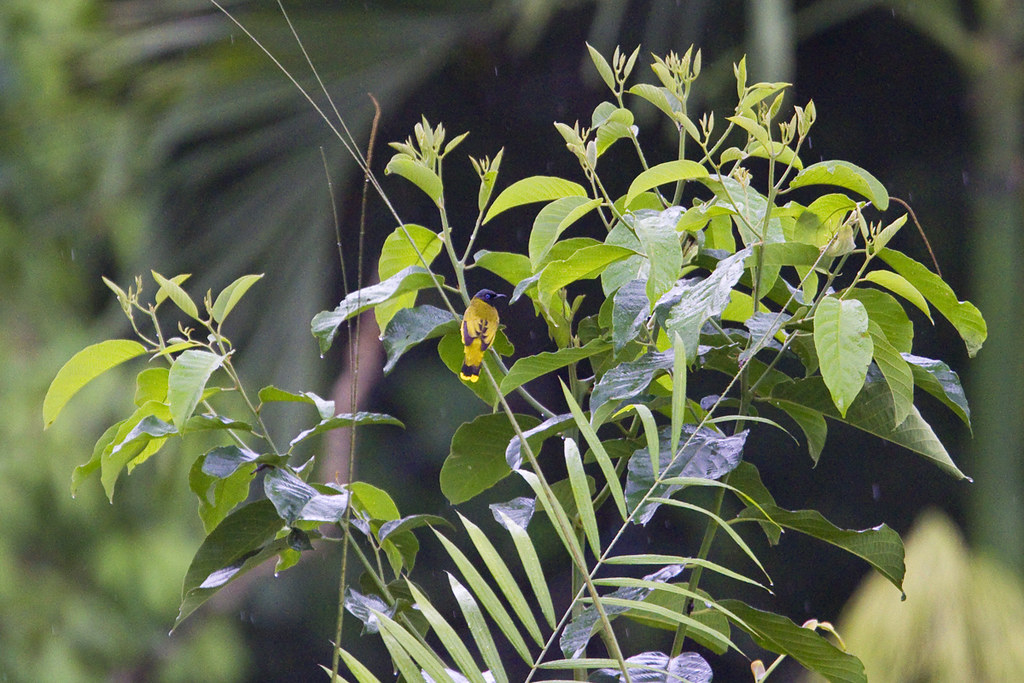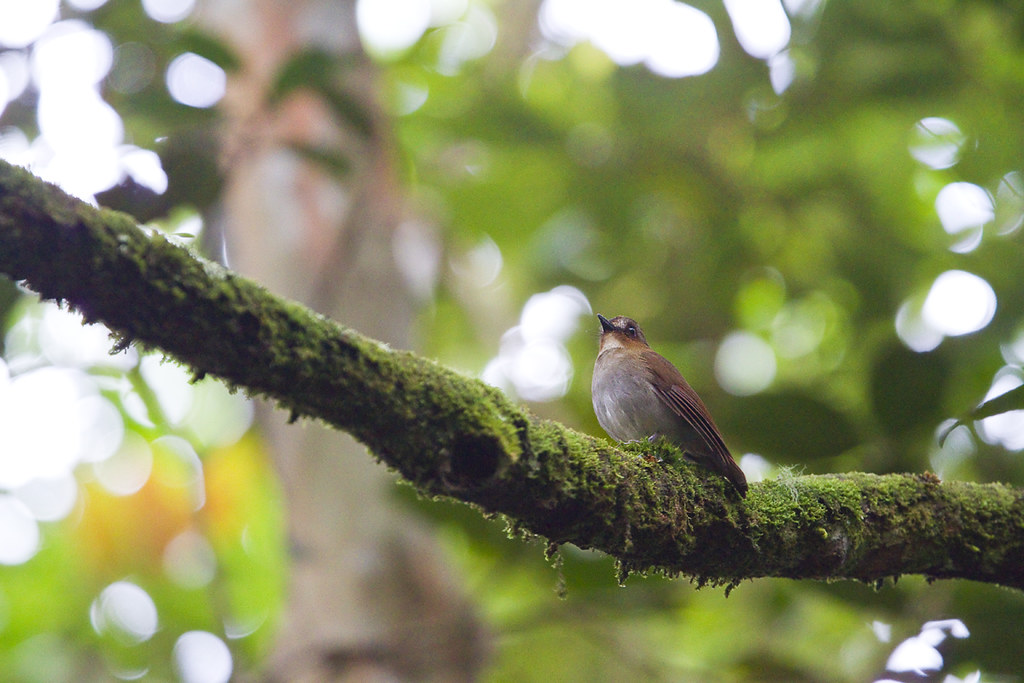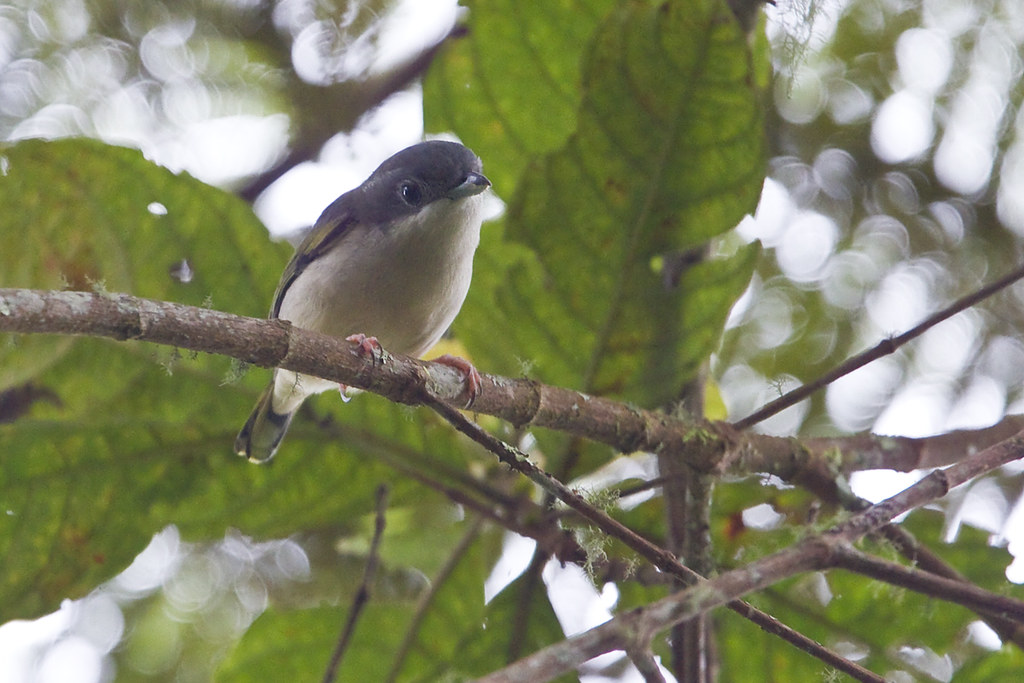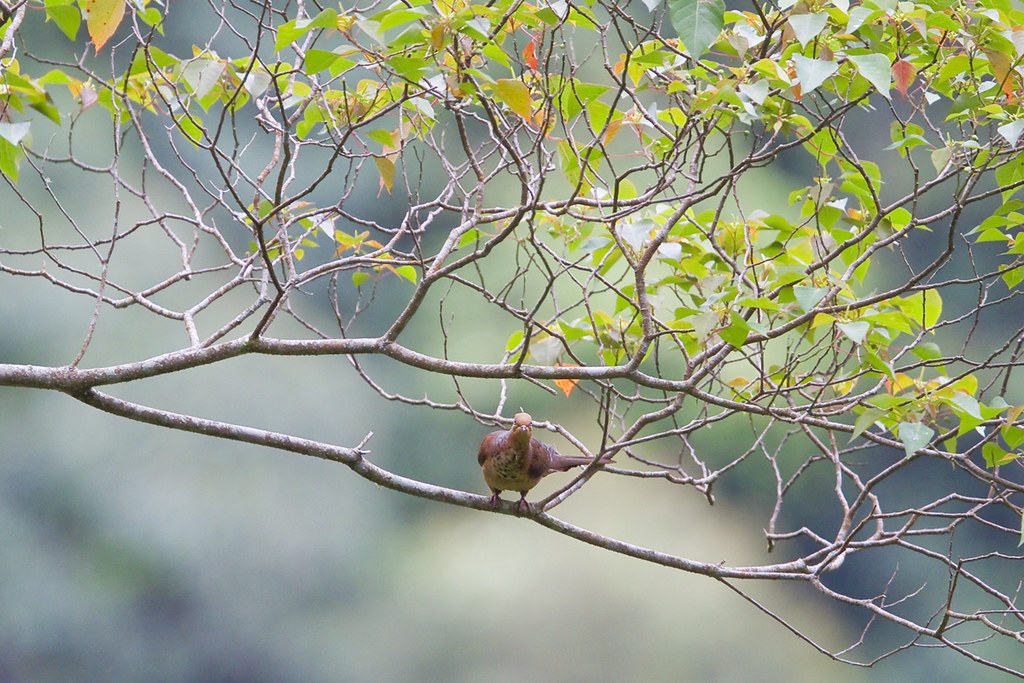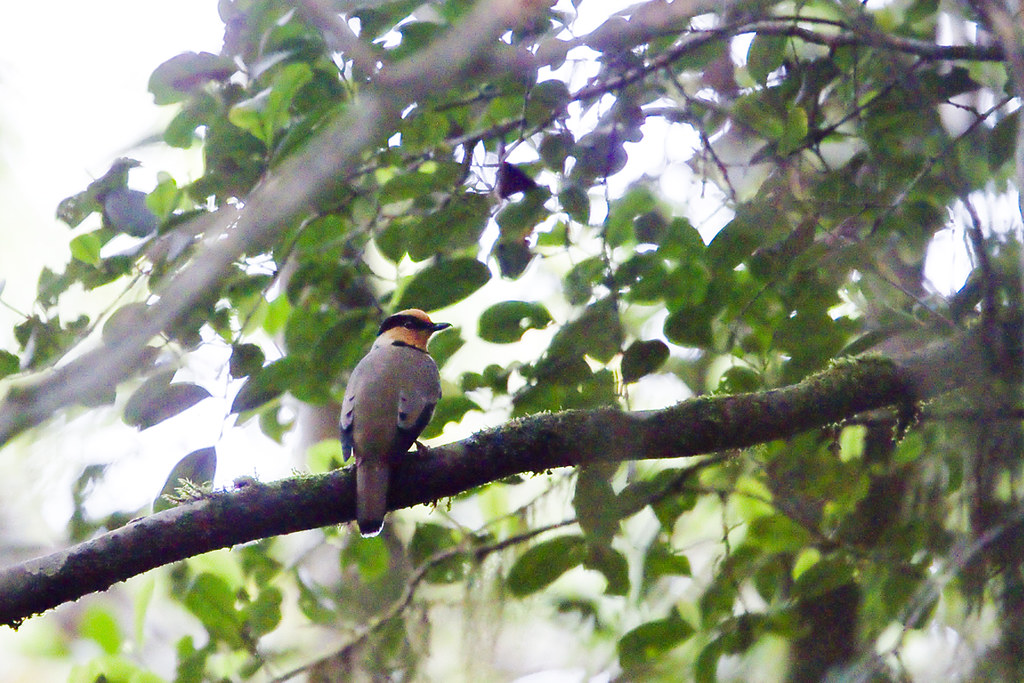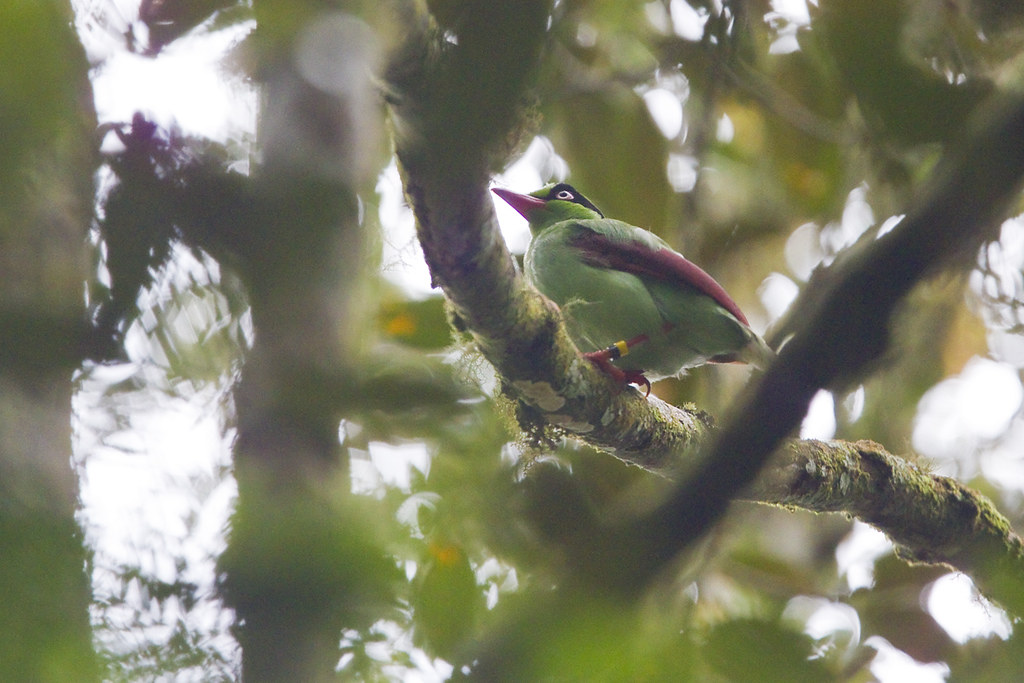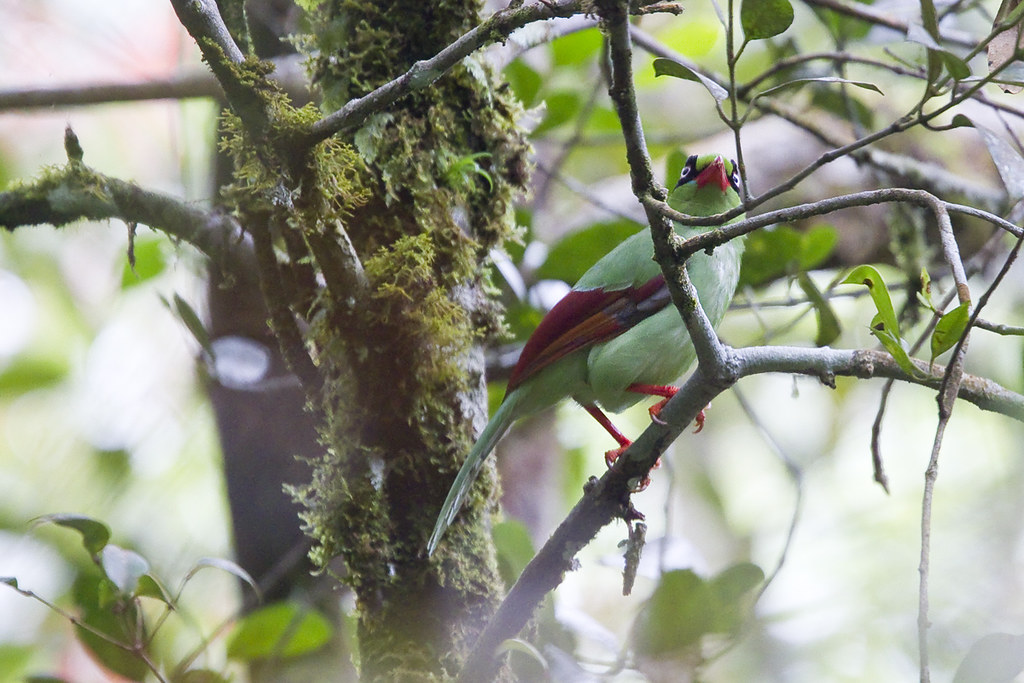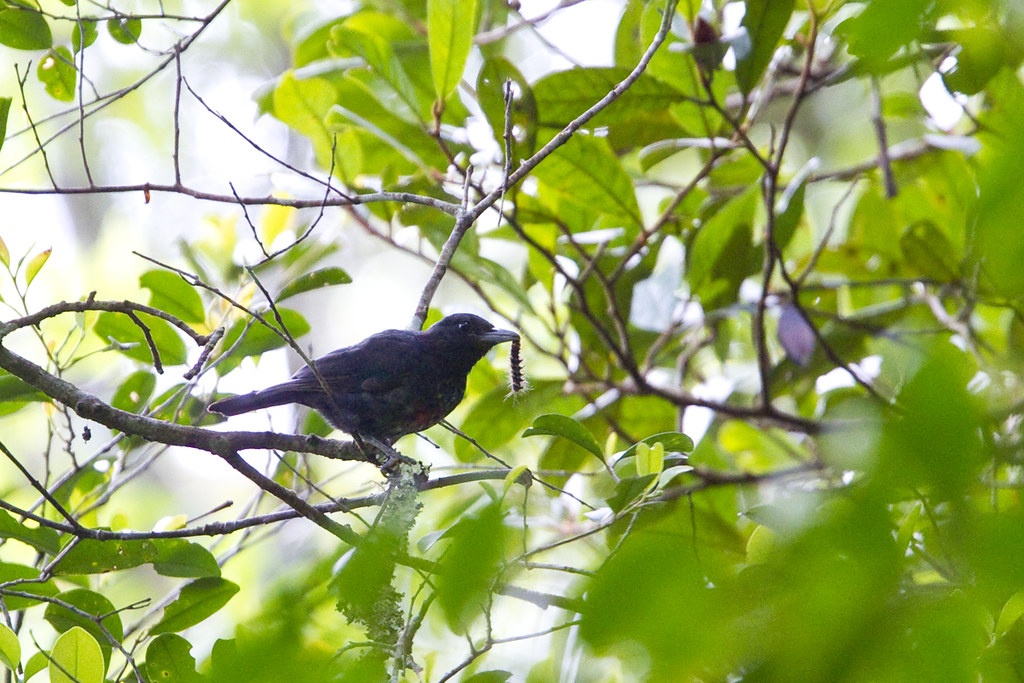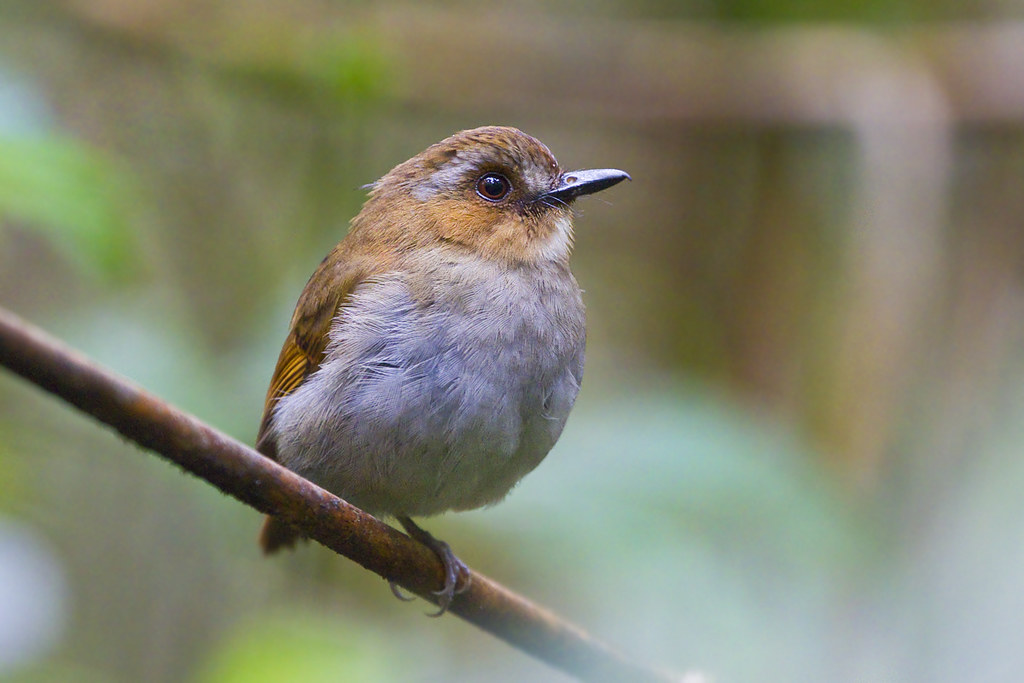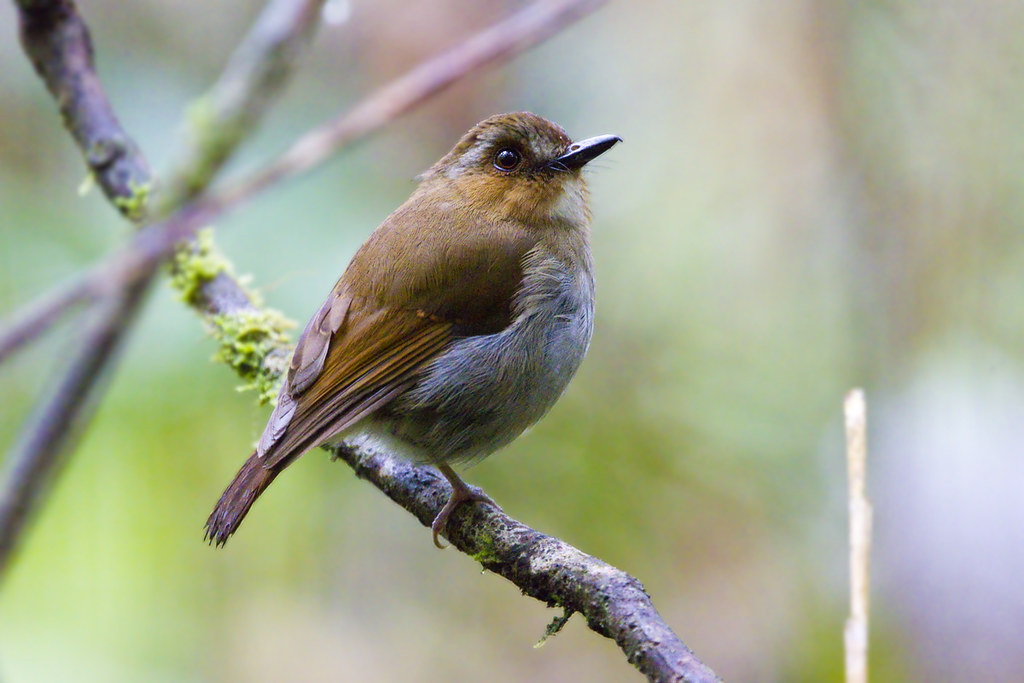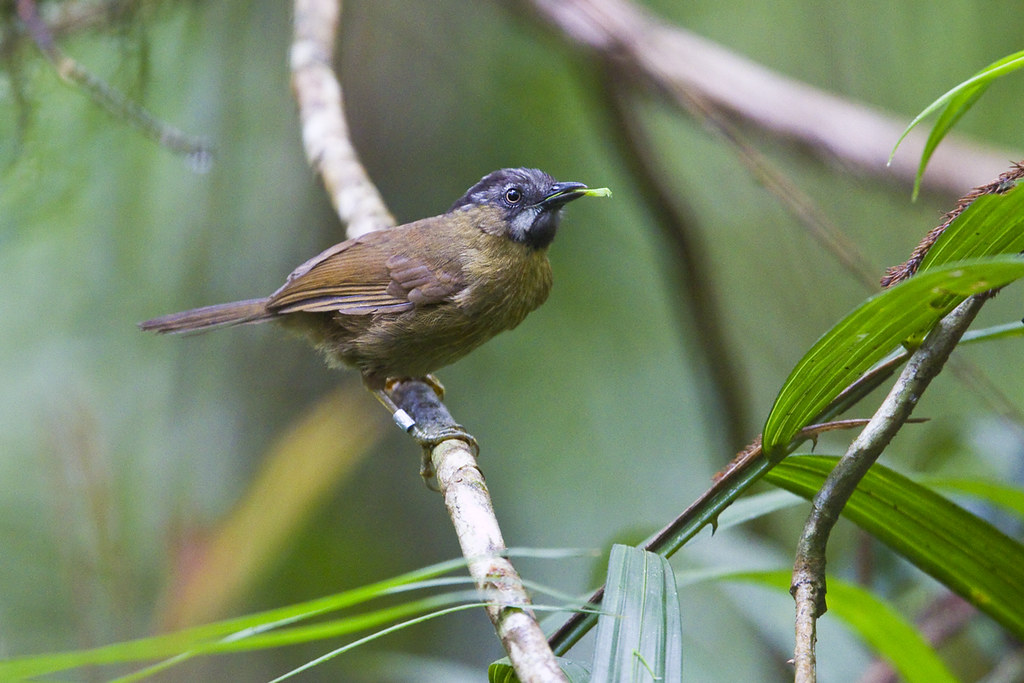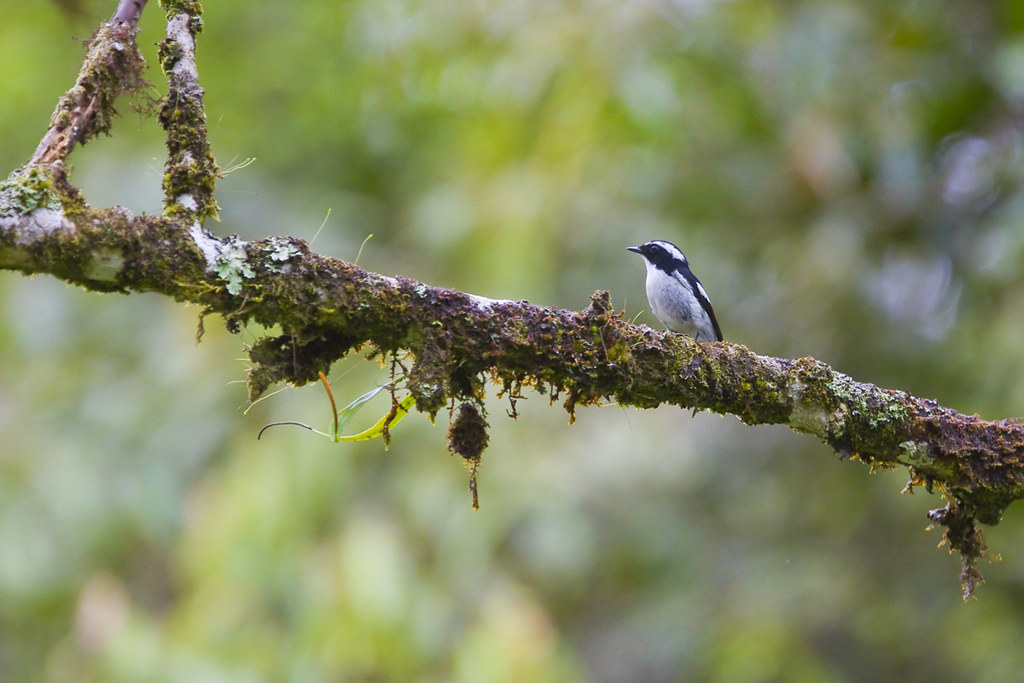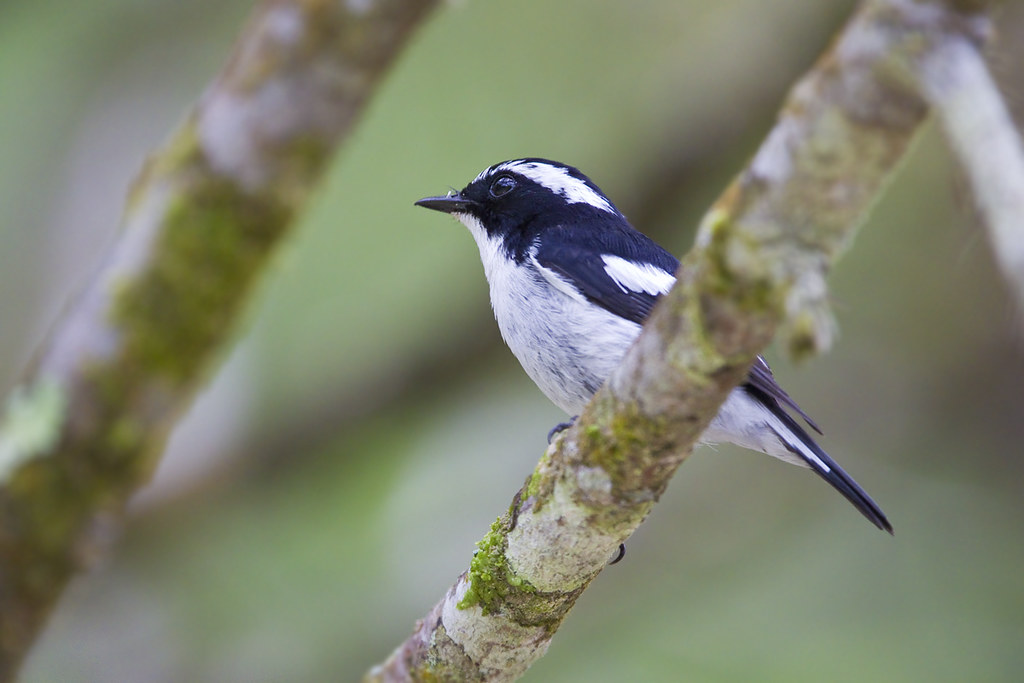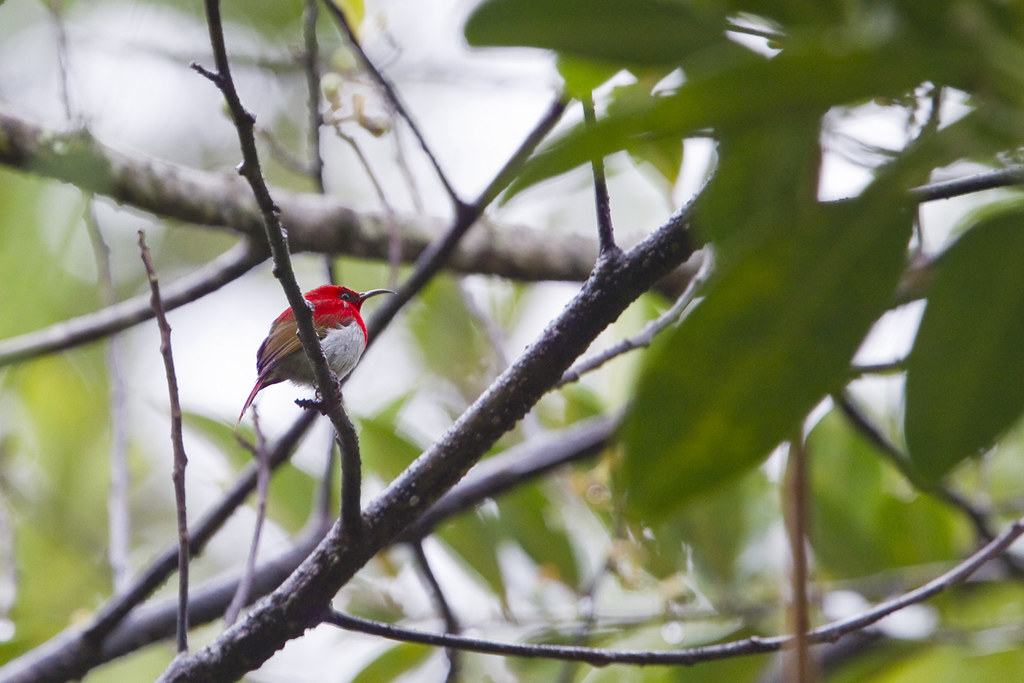17th May: Our last morning before flying back to Hong Kong, our flight was scheduled at 4:25pm, so we could still spend the morning birding. We decided not to go far as we didn't want to leave too late, so we birded the area around the resort and to Kipungit Waterfall. It started as usual near the trail gate, here we saw a Spectacled Bulbul and a very distant Gold-whiskered Barbet; they are more commonly heard then seen.
Spectacled Bulbul
Gold-whiskered Barbet
On our way towards the Kipungit Waterfall we heard a Raffle's Malkoha making it's unusual yelping call near by, we waited and soon got our eyes on them, a pair tending to a juvenile, feeding it in turns. This gave us an opportunity to finally appreciate this beautiful bird up close, the male differs from the grey headed female with it's rusty orange head. They gave us prolonged views for over 15 minutes, then we decided to leave them in peace to tend for their young.
Raffle's Malkoha male
female
We saw very little else on the trail so we headed back towards the trail entrance. There we encountered a few Black-capped Babbler, a very peculiar bird that walks like a wagtail half the time and when alarmed will hop onto branches in a very babbler like fashion. They continue to make their fairly distinctive "pi-weee" whistle as they hop into the bushes. Not far off, a pair of Crested Jays started calling, we heard the bird the day before but it never showed, this time they came upon our paths, however our meeting was short lived, they were only visible for ten seconds and flew straight off, disappearing into the trees, leaving us with their machine gun like call.
Black-capped Babbler
Crested Jay
At 7:45am, we saw a park staff walking up to the canopy walkway gate and opening it. We asked whether we can go in a little early but he insisted we waited till 8am; in the end he let us in five minutes early. The canopy walkway at Poring is quite popular amongst tourists, they are really just a series of very unstable rope bridges connected to wooden platforms between trees. However, having heard the Banded Broadbill and the Black-and-Yellow Broadbills calling constantly for two days made us want to go look for them up at the canopy. Early morning will be the best time to go up as all the tourists have yet to arrive, the walkway is quite crowded in late morning and afternoon. On our way up to the walkway we found a Greater Racket-tailed Drongo with no racket, hawking on insects from its perch. Suddenly, we were interrupted by a Buff-necked Woodpecker! With a little help of an audio playback, it came into full view and perched right above us! A very curious bird indeed.
Greater Racket-tailed Drongo
Buff-necked Woodpecker
On the canopy walkway we kept our eyes out for the Broadbills, but by 8:30am most have fallen silent. We did find a Verditer Flycatcher and a Red-throated Barbet up on the platform though. Then a Dark-throated Oriole came into sight, a fine male perched on a branch close-by, it circled around us a few times and left us in peace. Another bird was flushed, this time a Malaysian Hawk Cuckoo, distinguished from other Hawk Cuckoos by it's neck collar. On our way down, a Bornean Spiderhunter hopped into view, seems we interrupted it from feeding on a banana flower.
Dark-throated Oriole
Malaysian Hawk Cuckoo
Bornean Spiderhunter
Feeling quite content from the birds we saw on the last morning, we headed back to our room and packed our stuff. The drive was suppose to be three hours long so we spared some time and left at 10:45am, we arranged with the car rental company to pick the car up at the airport at 2pm. However, we were very much delayed by a car accident on the A4 on the way. The road was completely blocked for a solid two hours! The accident was horrific, a lorry crashed into two cars and killed one driver, others badly injured. So, advice will be to leave a little earlier if you can because the A4 and A1 are pretty much the ONLY road from Ranau to KK.
So that sums up our short trip to Kinabalu National Park. Some useful information below:
Book used:
"Birds of Borneo" - Susan Myers, Princeton Field Guides
Mobile Company:
-DIGI, 1 week data plan, 15RM
Car Rental:
- Extra Rent A Car : http://www.e-erac-online.com/
Accommodation:
- Tahubang Lodge (Mt. Kinabalu) [url]https://www.facebook.com/tohubang.lodge[/url]
- Serindit Hostel, Sutera Harbour (booked through Agoda)
Thursday, 29 May 2014
Wednesday, 28 May 2014
Kinabalu National Park, Sabah - May 2014 (Part 6)
16th May: We started our walk at 5:30am, park staff waited for us at the ticket checking booth to hand over our packed breakfast, we walked through the hot springs and made our way to the beginning of the trail. We stationed ourselves at a little garden beside the Langanan Waterfall trail's gate entrance, it's a good place to wait for birds activity as it's considerably brighter then the surrounding areas. The first activity started around 5:45am, as a flock of noisy Horsfield's Babbler foraged along the path. A Grey-cheeked Bulbul soon joined in, along with a Bornean Spiderhunter. We also saw a flying squirrel gliding across the trees!
Grey-cheeked Bulbul
Horsfield's Babbler
We started our steep climb to the waterfall, the trail was a bit wider then those at Mt. Kinabalu, but the rain have made it very slippery at some sections, a few fallen branches and trees blocked our way at a few locations. The other problem will be leeches, you can't go five minutes without seeing one making it's way up your shoes! So, leech socks will be highly recommended. The near 8km hike is claimed to take 2 hours there and 2 hours back, but being birders we of course walked at a slower pace. At Kipungit Waterfall you must cross the river by hopping on boulders, then it is a steep ascend towards the bat cave. The bat cave itself is not that impressive but you still get a wave of ammonium smell drifting towards you as you approach, there were some Swiftlets flying in and out of the cave which looked like Glossy to me. Past the bat cave we found a pair of Chestnut-backed Scimitar-Babblers, not far ahead a flock of Fluffy-backed Tit-Babblers made an appearance, however were so quick they were near impossible to photograph(for me)! Birding was fairly slow, the only other good birds were a pair of Raffle's Malkoha very high up at the canopy.
Chestnut-backed Scimitar-Babbler
Fluffy-backed Babbler (Record shot)
We arrived at some tall bamboos and decided to give the Blue-banded Pitta a try, nothing responded to the playback. Feeling slightly disappointed (though expected), we continued on the next corner and found a large flock of bulbuls gathered at a single fruiting tree, this consists of Hairy-backed Bulbuls, Scaly-breasted Bulbuls, Red-eyed Bulbuls and Spectacled Bulbul. A female Asian Fairy-Bluebird also made an appearance. A single Rufous Piculet was observed, however was too quick for me to take any photograph. We also saw a single Helmeted Hornbill around the area but was way behind the trees at the Canopy and flew away very quickly.
Hairy-backed Bulbul
Scaly-breasted Bulbul
Asian Fairy-Bluebird
The rest of the hike towards the waterfall was gruelling, it was hot and humid, bird activity seems to have came to a halt. We managed to pull ourselves up to the waterfall in the end, it was just around noon. The 120m tall waterfall itself was very impressive and the cool breeze gave us a refreshing refuge to rest. We ate our packed breakfast of sandwiches, fruits and a can of Sprite (definitely saved our lives) and headed down the trail again. It was much easier going down hill, and bird activities also seemed to have picked up a little. We first encountered a beautiful Chestnut-breasted Malkoha, then we heard an Orange-breasted Trogon not far off and found a male calling from a branch just beside the trail. Minutes later, a female Olive-backed Woodpecker gave us a brief eye-level view and disappeared up a trunk. Just as we thought our luck couldn't be getting any better in that short period of time, a pair of Red-naped Trogon started calling ahead, we slowly make our way forward and found the pair sitting quietly on the branches starring at us in a way only Trogons can do. The male especially gave us very close and prolonged views, showing off it's brilliant red nape and blue skin around it's eyes. Satisfied, we made our way back down to the resort for a very late lunch, it was 2:30pm by the time we got back.
Damselfly species
Langanan Waterfall
Chestnut-breasted Malkoha
Orange-breasted Trogon
Olive-backed Woodpecker
Red-naped Trogon female
Red-naped Trogon male
After a short rest in our air conditioned room, we headed back out in late afternoon. The sky was dark and we heard thunder coming our way but it never rained, we made good use of this surprisingly dry afternoon and walked the area around the Bamboo Garden and Tropical Garden. We found a family of Fulvous-breasted Jungle-flycatchers at the Bamboo Garden, they seems to be pretty abundant here at Poring. We also found a few Olive-winged Bulbuls. A flock of Chestnut-winged Babblers foraged nearby and a White-crowned Shama flew back and forth in the undergrowth, singing it's melodious song. You need to pay to enter the Tropical Garden but there was no one at the ticketing booth, the main door was opened though the gates towards the other exhibits were closed, we saw some domesticated Sambar Deers in there. A Plaintain Pygmy Squirrel and Low's Squirrel along with a few Rufous-crowned Babbler kept us entertained . A flock of Racket-tailed Drongo hawking along the road ended our day.
Fulvous-breasted Jungle-Flycatcher
Olive-winged Bulbul
Chestnut-winged Babbler
White-crowned Shamma
Sambar Deer
Plain Pygmy Squirrel
Low's Squirrel
Rufous-crowned Babbler
Grey-cheeked Bulbul
Horsfield's Babbler
We started our steep climb to the waterfall, the trail was a bit wider then those at Mt. Kinabalu, but the rain have made it very slippery at some sections, a few fallen branches and trees blocked our way at a few locations. The other problem will be leeches, you can't go five minutes without seeing one making it's way up your shoes! So, leech socks will be highly recommended. The near 8km hike is claimed to take 2 hours there and 2 hours back, but being birders we of course walked at a slower pace. At Kipungit Waterfall you must cross the river by hopping on boulders, then it is a steep ascend towards the bat cave. The bat cave itself is not that impressive but you still get a wave of ammonium smell drifting towards you as you approach, there were some Swiftlets flying in and out of the cave which looked like Glossy to me. Past the bat cave we found a pair of Chestnut-backed Scimitar-Babblers, not far ahead a flock of Fluffy-backed Tit-Babblers made an appearance, however were so quick they were near impossible to photograph(for me)! Birding was fairly slow, the only other good birds were a pair of Raffle's Malkoha very high up at the canopy.
Chestnut-backed Scimitar-Babbler
Fluffy-backed Babbler (Record shot)
We arrived at some tall bamboos and decided to give the Blue-banded Pitta a try, nothing responded to the playback. Feeling slightly disappointed (though expected), we continued on the next corner and found a large flock of bulbuls gathered at a single fruiting tree, this consists of Hairy-backed Bulbuls, Scaly-breasted Bulbuls, Red-eyed Bulbuls and Spectacled Bulbul. A female Asian Fairy-Bluebird also made an appearance. A single Rufous Piculet was observed, however was too quick for me to take any photograph. We also saw a single Helmeted Hornbill around the area but was way behind the trees at the Canopy and flew away very quickly.
Hairy-backed Bulbul
Scaly-breasted Bulbul
Asian Fairy-Bluebird
The rest of the hike towards the waterfall was gruelling, it was hot and humid, bird activity seems to have came to a halt. We managed to pull ourselves up to the waterfall in the end, it was just around noon. The 120m tall waterfall itself was very impressive and the cool breeze gave us a refreshing refuge to rest. We ate our packed breakfast of sandwiches, fruits and a can of Sprite (definitely saved our lives) and headed down the trail again. It was much easier going down hill, and bird activities also seemed to have picked up a little. We first encountered a beautiful Chestnut-breasted Malkoha, then we heard an Orange-breasted Trogon not far off and found a male calling from a branch just beside the trail. Minutes later, a female Olive-backed Woodpecker gave us a brief eye-level view and disappeared up a trunk. Just as we thought our luck couldn't be getting any better in that short period of time, a pair of Red-naped Trogon started calling ahead, we slowly make our way forward and found the pair sitting quietly on the branches starring at us in a way only Trogons can do. The male especially gave us very close and prolonged views, showing off it's brilliant red nape and blue skin around it's eyes. Satisfied, we made our way back down to the resort for a very late lunch, it was 2:30pm by the time we got back.
Damselfly species
Langanan Waterfall
Chestnut-breasted Malkoha
Orange-breasted Trogon
Olive-backed Woodpecker
Red-naped Trogon female
Red-naped Trogon male
After a short rest in our air conditioned room, we headed back out in late afternoon. The sky was dark and we heard thunder coming our way but it never rained, we made good use of this surprisingly dry afternoon and walked the area around the Bamboo Garden and Tropical Garden. We found a family of Fulvous-breasted Jungle-flycatchers at the Bamboo Garden, they seems to be pretty abundant here at Poring. We also found a few Olive-winged Bulbuls. A flock of Chestnut-winged Babblers foraged nearby and a White-crowned Shama flew back and forth in the undergrowth, singing it's melodious song. You need to pay to enter the Tropical Garden but there was no one at the ticketing booth, the main door was opened though the gates towards the other exhibits were closed, we saw some domesticated Sambar Deers in there. A Plaintain Pygmy Squirrel and Low's Squirrel along with a few Rufous-crowned Babbler kept us entertained . A flock of Racket-tailed Drongo hawking along the road ended our day.
Fulvous-breasted Jungle-Flycatcher
Olive-winged Bulbul
Chestnut-winged Babbler
White-crowned Shamma
Sambar Deer
Plain Pygmy Squirrel
Low's Squirrel
Rufous-crowned Babbler
Tuesday, 27 May 2014
Kinabalu National Park, Sabah - May 2014 (Part 5)
15th May: This was our last morning at Mount Kinabalu, and we were desperate to get the Trogon onto our list! We were up again before dawn, drove up to Timpohon Gate and waited. The sky was very clear after yesterday's shower, and we had an amazing view looking at the summit. The tamed Bornean Whistling Thrush was yet again there to greet us, it gave us very close views beneath the shelter at Timpohon Gate, it was picking insects off the floor; likely to be attracted by the lights that were left overnight, a free buffet for birds! Activity was surprisingly low, with the usual crowd of birds. Around 6:30, a group of birdwatchers arrived, and who may it be but David Bishop, leading a group of American birders! It was a huge coincidence as we met each other the last time I visited Sabah at Danum Valley in July 2012, and here we met again in Sabah at another location, what were the chances! It was their first day at Mt. Kinabalu, so we exchanged some information about whereabouts of birds including the Fruithunter's location, he pointed out we should try find the Trogon by the main road along Silau-Silau trail.
Bornean Whistling Thrush
But before that, we decided to try out Bukit Ular trail, supposedly the most likely trail you will encounter the elusive Everett's Thrush. However, we saw very little in the trail, except for a huge group of Long-tailed Macaque. So we got back to our car as quick as possible and drove down to the Silau-Silau trail. As we birded along the road we met David again and he pointed out a group have just been photographing the Trogons at the 1.5km mark earlier in the morning! So off we went to the location, by that time it was 9:30am, and we knew it was a long shot, but we gave it our best and waited for an hour. The Trogon never came, only a flock of Ochraceous Bulbul and a pair of Indigo Flycatchers. Having arranged to check out by 10:30am, we left and accepted it was not our time to see the Trogon this time, it will have to wait!
Ochraceous Bulbul
Indigo Flycatcher
It was a very short and straight forward drive to Poring, stopped at Ranau to refuel and we arrived at the reception by 11:30am. Poring Hot Spring is a local holiday resort that boasts it's natural hot springs and is very popular amongst local bathers. The weather was considerably hotter then that of Mount Kinabalu. We stayed at the pre-booked Serindit Hostel, a comfortable shared building with private rooms but shared bathrooms and TV lounge. It was a lot more luxurious then Tahubang Lodge and includes breakfast, but the price was also considerably higher. Birding was done mainly on a single trail leading towards Langanan Waterfall, the trail is 3.8km one way, mostly up steep hill. As we plan to start our walk to the waterfall trail early tomorrow morning, we arrange a packed breakfast service with the reception. The staffs were very friendly and helpful, so all in all i think the higher price tag is still acceptable and considering we are only staying here for two nights it's not so bad.
During lunch we sat at the balcony looking out, here we spotted many lowland species such as Red-eyed Bulbul, Common Iora, Black-winged Flycatcher-shrike and Lesser Green Leafbird. However they were on a tree very far away and there really wasn't much point in photographing them. It started raining during lunch so we retreated to our air conditioned rooms until the rain subsided.
Red-eyed Bulbul
Once the rain stopped we headed out, we walked the area around the football field as well as walking to the Kipungit Waterfall; a much smaller waterfall compared with Langanan but still nice to see. We spotted an out of place Mountain Barbet at a fruiting tree, Brown Fulvettas, Crimson Sunbirds, Black-headed Bulbul at a distance and other bulbul species such as Red-eyed, Spectacled and Scaly-breasted Bulbul, all too far away.
Mountain Barbet
Brown Fulvetta
Crimson Sunbird
Black-headed Bulbul
Bornean Whistling Thrush
But before that, we decided to try out Bukit Ular trail, supposedly the most likely trail you will encounter the elusive Everett's Thrush. However, we saw very little in the trail, except for a huge group of Long-tailed Macaque. So we got back to our car as quick as possible and drove down to the Silau-Silau trail. As we birded along the road we met David again and he pointed out a group have just been photographing the Trogons at the 1.5km mark earlier in the morning! So off we went to the location, by that time it was 9:30am, and we knew it was a long shot, but we gave it our best and waited for an hour. The Trogon never came, only a flock of Ochraceous Bulbul and a pair of Indigo Flycatchers. Having arranged to check out by 10:30am, we left and accepted it was not our time to see the Trogon this time, it will have to wait!
Ochraceous Bulbul
Indigo Flycatcher
It was a very short and straight forward drive to Poring, stopped at Ranau to refuel and we arrived at the reception by 11:30am. Poring Hot Spring is a local holiday resort that boasts it's natural hot springs and is very popular amongst local bathers. The weather was considerably hotter then that of Mount Kinabalu. We stayed at the pre-booked Serindit Hostel, a comfortable shared building with private rooms but shared bathrooms and TV lounge. It was a lot more luxurious then Tahubang Lodge and includes breakfast, but the price was also considerably higher. Birding was done mainly on a single trail leading towards Langanan Waterfall, the trail is 3.8km one way, mostly up steep hill. As we plan to start our walk to the waterfall trail early tomorrow morning, we arrange a packed breakfast service with the reception. The staffs were very friendly and helpful, so all in all i think the higher price tag is still acceptable and considering we are only staying here for two nights it's not so bad.
During lunch we sat at the balcony looking out, here we spotted many lowland species such as Red-eyed Bulbul, Common Iora, Black-winged Flycatcher-shrike and Lesser Green Leafbird. However they were on a tree very far away and there really wasn't much point in photographing them. It started raining during lunch so we retreated to our air conditioned rooms until the rain subsided.
Red-eyed Bulbul
Once the rain stopped we headed out, we walked the area around the football field as well as walking to the Kipungit Waterfall; a much smaller waterfall compared with Langanan but still nice to see. We spotted an out of place Mountain Barbet at a fruiting tree, Brown Fulvettas, Crimson Sunbirds, Black-headed Bulbul at a distance and other bulbul species such as Red-eyed, Spectacled and Scaly-breasted Bulbul, all too far away.
Mountain Barbet
Brown Fulvetta
Crimson Sunbird
Black-headed Bulbul
Monday, 26 May 2014
Kinabalu National Park, Sabah - May 2014 (Part 4)
14th May: We got up the same time again and left on the car by 5:30am. Again, the drive up produced no Everett's Thrush, however a stop at the view point had us listening to a Sunda Cuckoo far away. The "usuals" were there in the form of Sunda and Chestnut-hooded Laughingthrush, as well as the Whistling Thrush. A new bird to us was the Eye-browed Jungle-Flycatcher, another mountain endemic to our list! A bird wave soon arrived, with Mountain Leaf Warblers, Black-capped White-eyes, Yellow-breasted Warblers, Grey-chinned Minivets, Bornean Whistlers and a single female Blyth's Shrike-babbler. We waited for the partridges, hoping our luck from the previous morning will continue, but nothing. They kept at a distance and didn't come closer. Not far off a fruiting tree with a dozen of Little Cuckoo-dove, but they were at quite a distance, however were close enough that we checked that there were no Ruddy Cuckoo-dove amongst them.
Eye-browed Jungle-Flycatcher
Blyth's Shrike-babbler
Little Cuckoo-dove
Little else were seen around Timpohon Gate, so we drove down to Mempening Trail once more, we plan to walk from Mempening trail all the way to Bukit Burung trail and back up the Silau-Silau trail onto the Power Station Road, weather was very good with the sun coming out, we took that as a good sign. And once again 20 meters in, the Fruithunter was there again, this time a little further away, but again collecting moss as nesting materials. It gave us a much longer time to appreciate it's features then disappeared once again into the jungle.
Fruithunter
We took this as a good omen and pressed on, however activities stopped completely and we saw nothing for the next hour or so. It was until we went passed Bukit Burung shelter that activities started to pick up once more. There we encountered a flock of Bornean Green Magpies, with it came a flock of Bornean Treepies and a pair of Checker-throated Woodpecker. Further on, a Black-and-Crimson Oriole joined in, foraging with the group. As we went passed the Bukit Buring shelter walking on a ridge, we heard the call of a Whitehead's Broadbill, it wasn't far off so we immediately scanned the trees for any movement, but nothing moved. There we could see the Power Station Road, and actually it wasn't too far off where we saw the Broadbill on the first day, so we thought it could be the same individual or pair, but we will never know for sure.
Bornean Green Magpie
Checker-throated Woodpecker
Black-and-Crimson Oriole
As we got to Silau-Silau trail, things quietened down a little, but was still nice as a very bold Eye-browed Jungle-Flycatcher made an appearance to forage along a flock of Grey-throated Babblers. Further up ahead a beautiful male Snowy-browed Flycatcher gave us a good look before flying off. We kept our eyes out for the Whitehead's Trogon as we've heard this is the trail you will most likely see them, but saw nothing. As we hit the Power Station Road, we connected with another flock of Green Magpies and Checker-throated Woodpeckers; this time with three. Walking all the way back up to our car we drove down to Liwagu Restaurant for lunch.
Eye-browed Jungle-Flycatcher
Grey-throated Babbler
Snowy-browed Flycatcher male
Rain was a big issue that afternoon, it was very heavy at times and surely we couldn't walk the trails in this condition. So, we decided to wait out at the garden outside the restaurant hoping something will appear. There we found a smart looking male Little Pied Flycatcher, singing away on it's perch. It later decided to come check us out and flew right up in front of us on a low branch, either it was just bold or it was claiming it's territory against us. We saw little else though, except for a little more cooperative Temminck's Sunbird, another common mountain endemic. They are actually very common and can be heard and seen everywhere, however none decide to come down to feed at the flowers while we were there, so I have to live with having just a distance photograph of them. However they are still a delightful bird to see, a dazzling Ferrari red. With the heavy showers continuing, we decided to call it a day early. The rain continued on all night.
Little Pied Flycatcher
Temminck's Sunbird
To be continued...
Eye-browed Jungle-Flycatcher
Blyth's Shrike-babbler
Little Cuckoo-dove
Little else were seen around Timpohon Gate, so we drove down to Mempening Trail once more, we plan to walk from Mempening trail all the way to Bukit Burung trail and back up the Silau-Silau trail onto the Power Station Road, weather was very good with the sun coming out, we took that as a good sign. And once again 20 meters in, the Fruithunter was there again, this time a little further away, but again collecting moss as nesting materials. It gave us a much longer time to appreciate it's features then disappeared once again into the jungle.
Fruithunter
We took this as a good omen and pressed on, however activities stopped completely and we saw nothing for the next hour or so. It was until we went passed Bukit Burung shelter that activities started to pick up once more. There we encountered a flock of Bornean Green Magpies, with it came a flock of Bornean Treepies and a pair of Checker-throated Woodpecker. Further on, a Black-and-Crimson Oriole joined in, foraging with the group. As we went passed the Bukit Buring shelter walking on a ridge, we heard the call of a Whitehead's Broadbill, it wasn't far off so we immediately scanned the trees for any movement, but nothing moved. There we could see the Power Station Road, and actually it wasn't too far off where we saw the Broadbill on the first day, so we thought it could be the same individual or pair, but we will never know for sure.
Bornean Green Magpie
Checker-throated Woodpecker
Black-and-Crimson Oriole
As we got to Silau-Silau trail, things quietened down a little, but was still nice as a very bold Eye-browed Jungle-Flycatcher made an appearance to forage along a flock of Grey-throated Babblers. Further up ahead a beautiful male Snowy-browed Flycatcher gave us a good look before flying off. We kept our eyes out for the Whitehead's Trogon as we've heard this is the trail you will most likely see them, but saw nothing. As we hit the Power Station Road, we connected with another flock of Green Magpies and Checker-throated Woodpeckers; this time with three. Walking all the way back up to our car we drove down to Liwagu Restaurant for lunch.
Eye-browed Jungle-Flycatcher
Grey-throated Babbler
Snowy-browed Flycatcher male
Rain was a big issue that afternoon, it was very heavy at times and surely we couldn't walk the trails in this condition. So, we decided to wait out at the garden outside the restaurant hoping something will appear. There we found a smart looking male Little Pied Flycatcher, singing away on it's perch. It later decided to come check us out and flew right up in front of us on a low branch, either it was just bold or it was claiming it's territory against us. We saw little else though, except for a little more cooperative Temminck's Sunbird, another common mountain endemic. They are actually very common and can be heard and seen everywhere, however none decide to come down to feed at the flowers while we were there, so I have to live with having just a distance photograph of them. However they are still a delightful bird to see, a dazzling Ferrari red. With the heavy showers continuing, we decided to call it a day early. The rain continued on all night.
Little Pied Flycatcher
Temminck's Sunbird
To be continued...
Subscribe to:
Comments (Atom)
